33 Wild Animals in South Africa [Wildlife in South Africa]
Want to know more about the wildlife in South Africa?
Discover 33 wild animals in South Africa in this post, as well as interesting facts about them. 🇿🇦
Learn All About South African Animals
Ready to learn all about South African animals?
I’ve always been fascinated by animals, and by how they can be so different from one country to another. In this guide, we’ll focus on the many animals South Africa has on the land, in the sky, and underwater.
I’ve split the guide into 4 categories:
- Native animals of South Africa
- Most endangered animals of South Africa
- What is the South African national animal?
- How many animals native to South Africa?
Let’s dive in right away with our first category!
Native Animals from South Africa
South Africa is an African country located in the southern part of the continent, at the tip of it. It is infamous for apartheid (imposed in 1948, for which Nelson Mandela played an extremely important role), suffers from poverty, crime, and inequality, is an upper-middle power, and used to be a Dutch colony, from which it developed its special language, Afrikaans. It is bordered by Namibia, Lesotho, Botswana, Eswatini, Zimbabwe, and Mozambique, and while its largest city is Johannesburg, its judicial capital is Bloemfontein and its legislative capital is Cape Town, its capital is Pretoria, which counts more than 741,000 inhabitants (but more than 2,921,000 if you include the metropolitan area).
An interesting part of the country that I wanted to tackle is its wildlife. In light of that, I have listed the best of it, and I hope you will love learning what animals live in South Africa.
Here’s the South Africa animals list.
1. Southern African lion
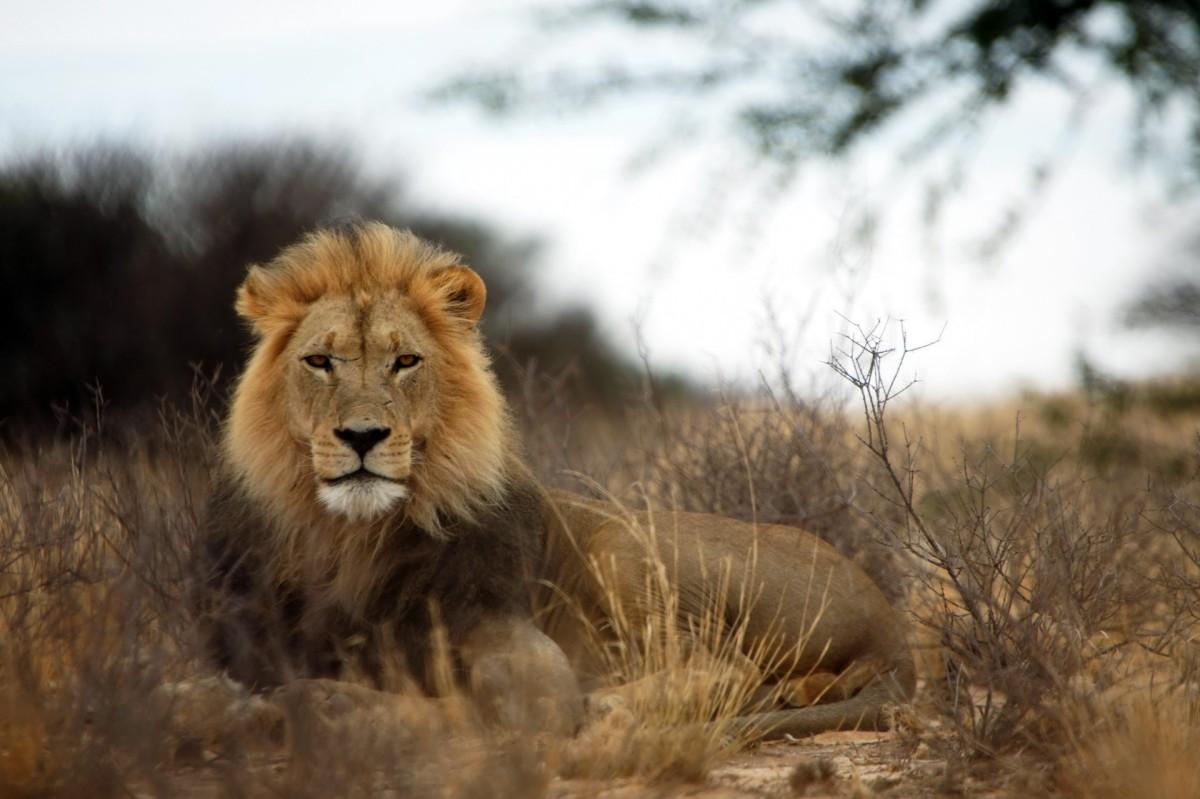
- Name: Southern African lion
- Scientific name: Panthera leo melanochaita
- Conservation status:
The Southern African lion, also known as the Southern lion, is a subspecies of the lion native to southern and eastern Africa. It is considered vulnerable to extinction, mainly due to trophy hunting, poaching, depletion of prey, and habitat fragmentation and loss.
The king of the jungle’s populations are on the decline in South Africa, where the Cape lion population was eradicated by 1860. While 34 specimens were reintroduced into the wild between 2000 and 2004, about 18 others were hunted as trophies and 11 were euthanized in the subsequent years.
2. Cape buffalo
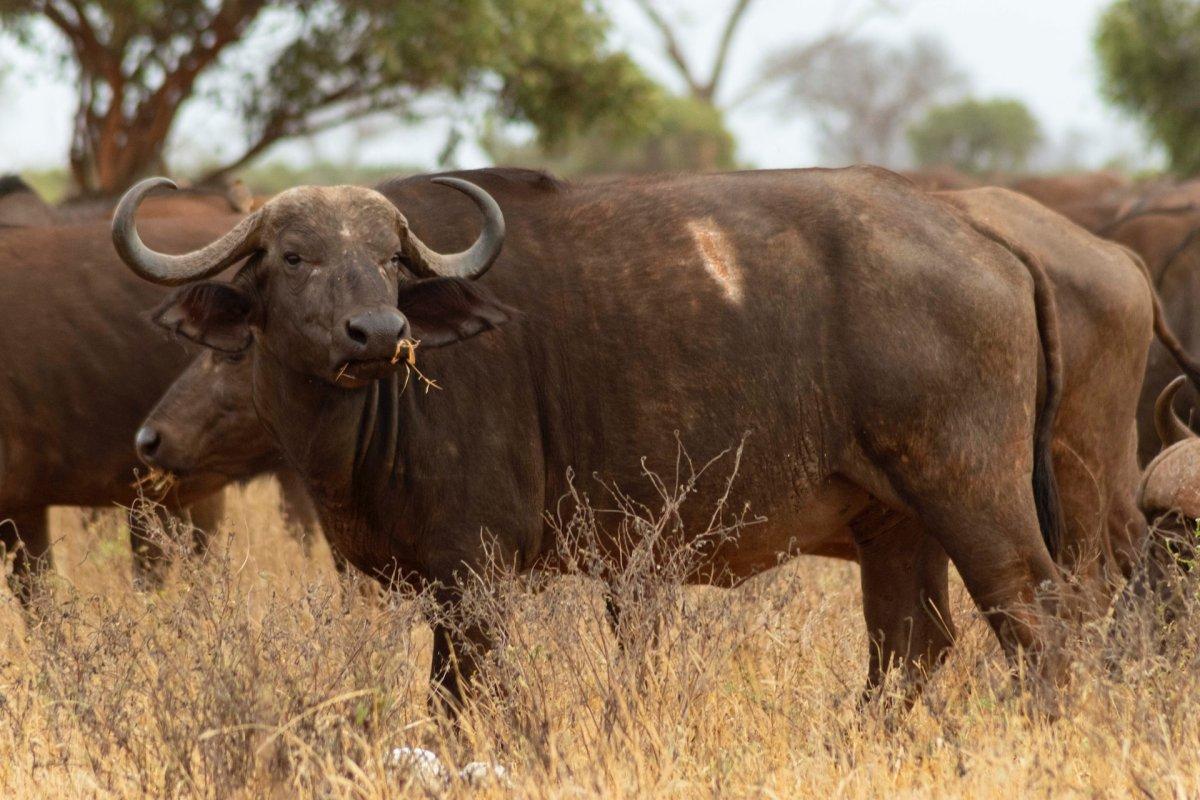
- Name: Cape buffalo
- Scientific name: Syncerus caffer caffer
- Conservation status:
The Cape buffalo is the typical subspecies of the African buffalo. It has a bone shield on top of its head and is a large species of wild bovine native to southern and eastern Africa. It is the largest of the African buffalos and can be found in savannas.
This bovid is well-known for its very unpredictable temperament and its possibly highly aggressive behavior: it has already trampled, gored, and even killed humans, which is why it has never been domesticated.
3. Gemsbok

- Name: Gemsbok
- Scientific name: Oryx gazella
- Conservation status:
The gemsbok, also known as the gemsbuck or the South African oryx, is a large species of antelope native to the arid areas of southern Africa, mainly in the Kalahari Desert. It is a very important symbol in the neighboring country of Namibia, and there are about 373,000 individuals there.
The name of this animal means “male chamois” in Afrikaans, although these two species are not closely related.
4. Greater kudu
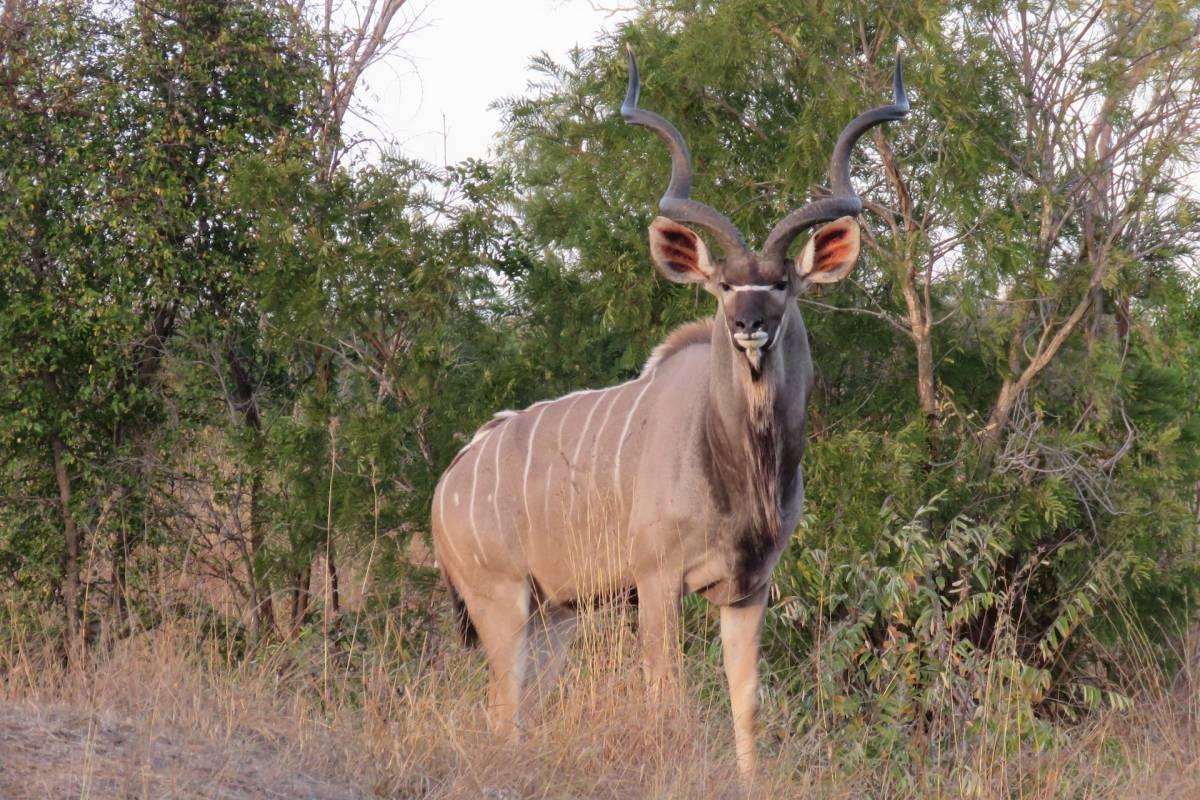
- Name: Greater kudu
- Scientific name: Tragelaphus strepsiceros
- Conservation status:
The greater kudu is a species of antelope found in southern and eastern Africa. Although it is considered of least concern, has fairly large numbers, and occupies a very wide range, it is on the decline because of deforestation and poaching.
The mating season lasts from April to May in South Africa, and while adult males are usually solitary, they join the group of females and their calves during this period of the year.
5. Burchell’s zebra
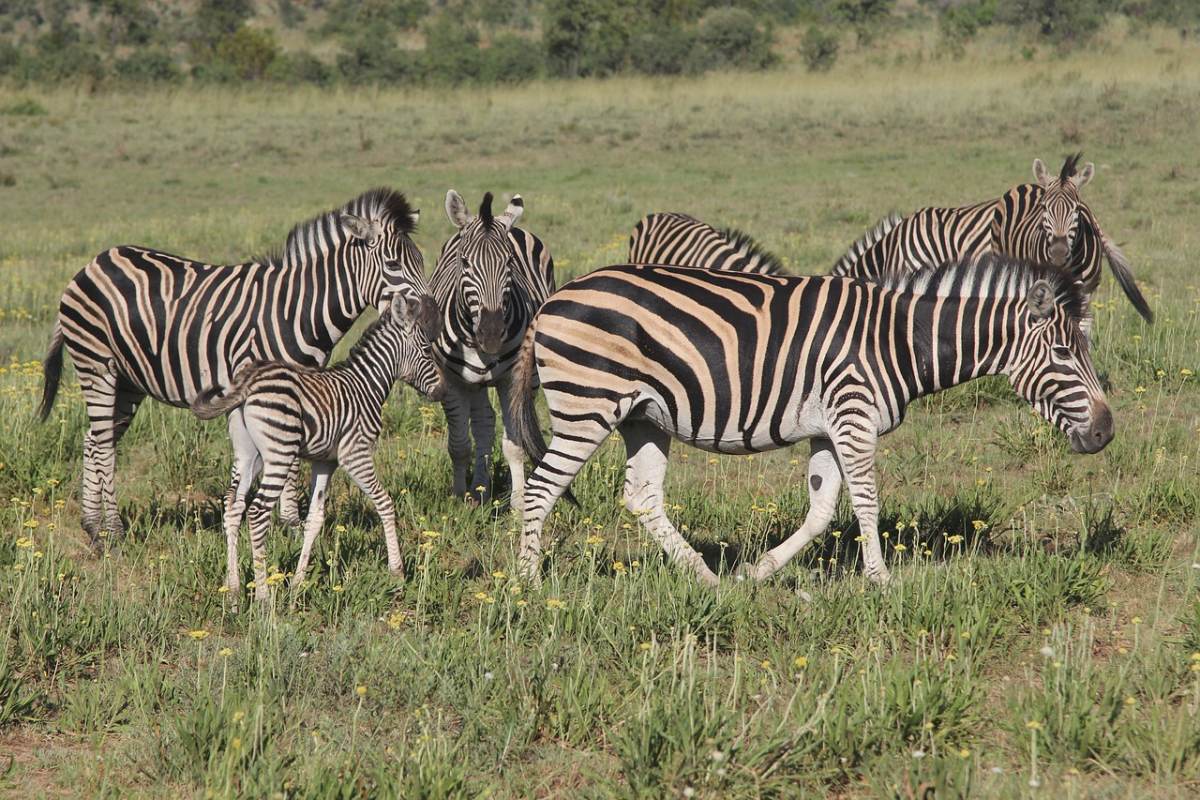
- Name: Burchell’s zebra
- Scientific name: Equus quagga burchellii
- Conservation status:
Burchell’s zebra, also known as the Zululand zebra, the bonte quagga, or the Damaraland zebra, is a subspecies of the plains zebra. It can be found in the southern parts of the African continent and is the only zebra subspecies that may be legally farmed for human consumption.
This mammal migrates the longest distance of any terrestrial animal in all of Africa, making a trip of about 500 km / 300 mi each year, usually along a straight north-south route.
6. Black rhinoceros
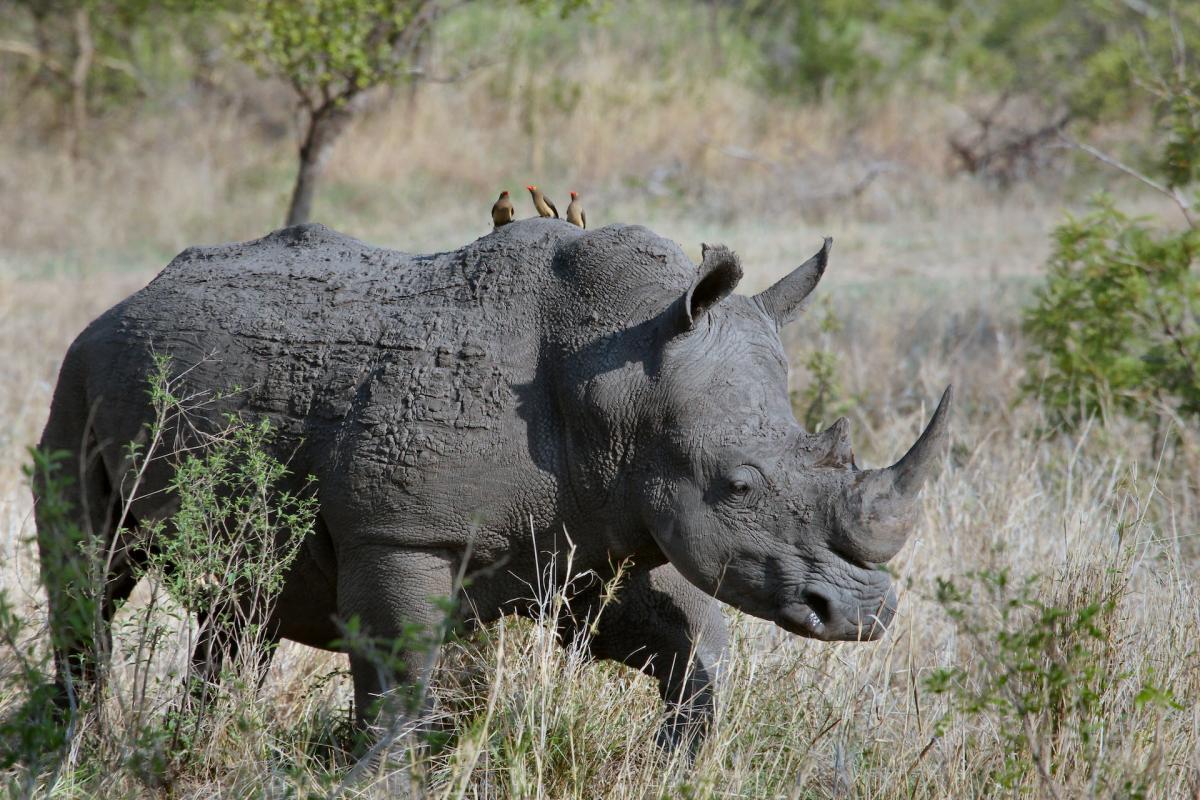
- Name: Black rhinoceros
- Scientific name: Diceros bicornis
- Conservation status:
The black rhinoceros, also known as the hook-lipped rhinoceros or the black rhino, is a species of rhinoceros native to southern and eastern Africa, including countries such as South Africa, Tanzania, Kenya, Botswana, and Zimbabwe. Despite its name, it is not black at all, but rather brown to gray.
This rhinoceros is extremely endangered and is one of the rarest large animals in Africa, with 3 of its subspecies being already extinct. However, thanks to conservation and reintroduction programs, its global population is slowly increasing.
7. Geometric tortoise
- Name: Geometric tortoise
- Scientific name: Psammobates geometricus
- Conservation status:
The geometric tortoise is a species of tortoise endemic to the South-Western Cape of South Africa, and it is on the brink of extinction. It has a very strong, yellow, and black patterned carapace, ideal for defense against potential predators.
The reasons for the decline of this tortoise are habitat fragmentation and loss due to frequent fires, predation from introduced species, and an increase in introduced plant species. Not only is South Africa home to one of the most endangered tortoises in the world, but it is also home to the most tortoise species on the planet!
8. Black mamba
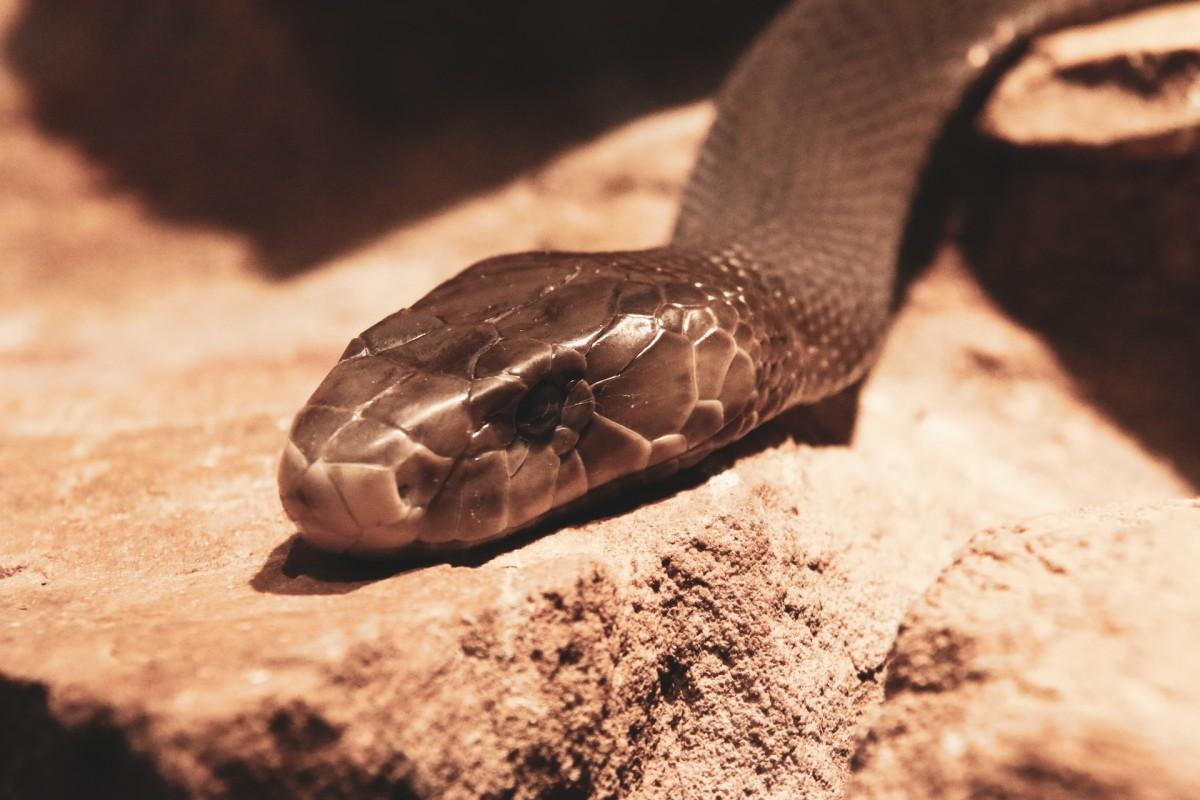
- Name: Black mamba
- Scientific name: Dendroaspis polylepis
- Conservation status:
The black mamba is a highly venomous species of snake native to sub-Saharan Africa, mainly in two disjunct areas: central and eastern Africa, and southern Africa. In South Africa, it can be found in the northeastern part of the country, where it inhabits savannas, woodlands, dense forests, and rocky slopes.
This snake is the second-longest venomous snake after the king cobra, reaching lengths of up to 4.5 m / 14 ft 9 in! Its venom is extremely dangerous (most of the time fatal if not immediately treated), and it is able to deliver multiple, long-ranged rapid strikes.
9. Common ostrich
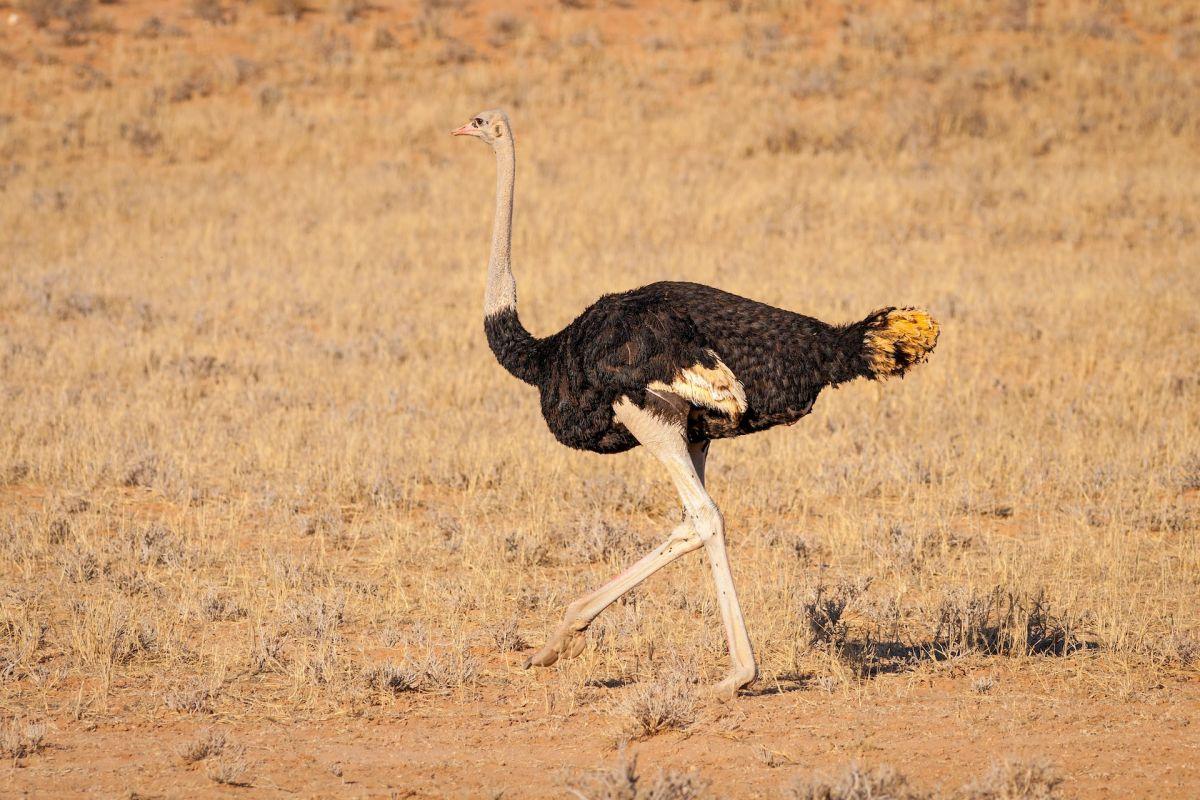
- Name: Common ostrich
- Scientific name: Struthio camelus
- Conservation status:
The common ostrich is a large species of flightless bird native to large areas of sub-Saharan Africa. Its 4 main subspecies are the northern ostrich (the largest bird in the world), the Masai ostrich, the South African ostrich, and the extinct Arabian ostrich.
There are plenty of ostriches in South Africa’s open grasslands and savanna areas, and not only are their size impressive, but they can also reach outstanding speeds of up to 70 km/h / 40 mph, which is the fastest land speed of any bird!
10. Brown greater galago
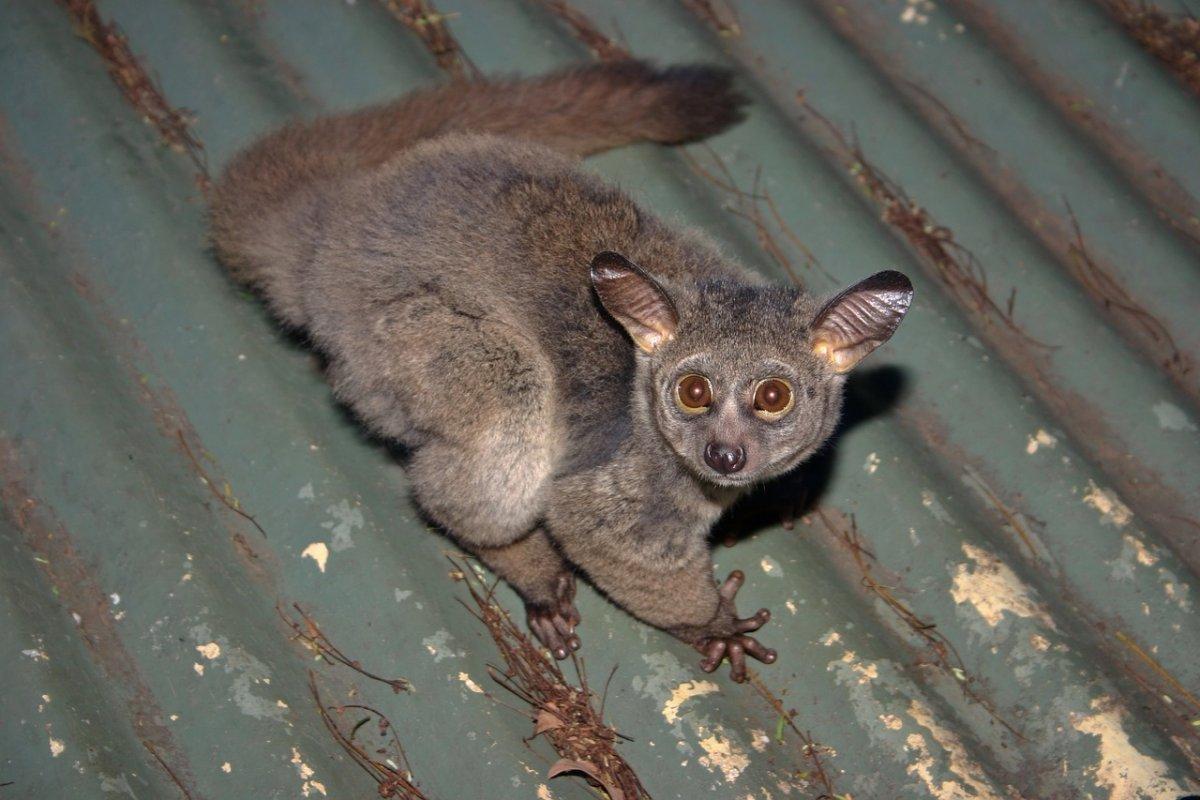
- Name: Brown greater galago
- Scientific name: Otolemur crassicaudatus
- Conservation status:
The brown greater galago, also known as the thick-tailed galago or the large-eared greater galago, is a species of primate native to the crossroads between central and southern Africa: it can only be found in northeastern South Africa, which is the southernmost part of its range.
This primate is nocturnal, and instead of leaping, it prefers running, walking, or climbing, opposite to most other, smaller galago species. Its South African range is seriously declining because of forestry and sugar cane plantations.
11. African bush elephant
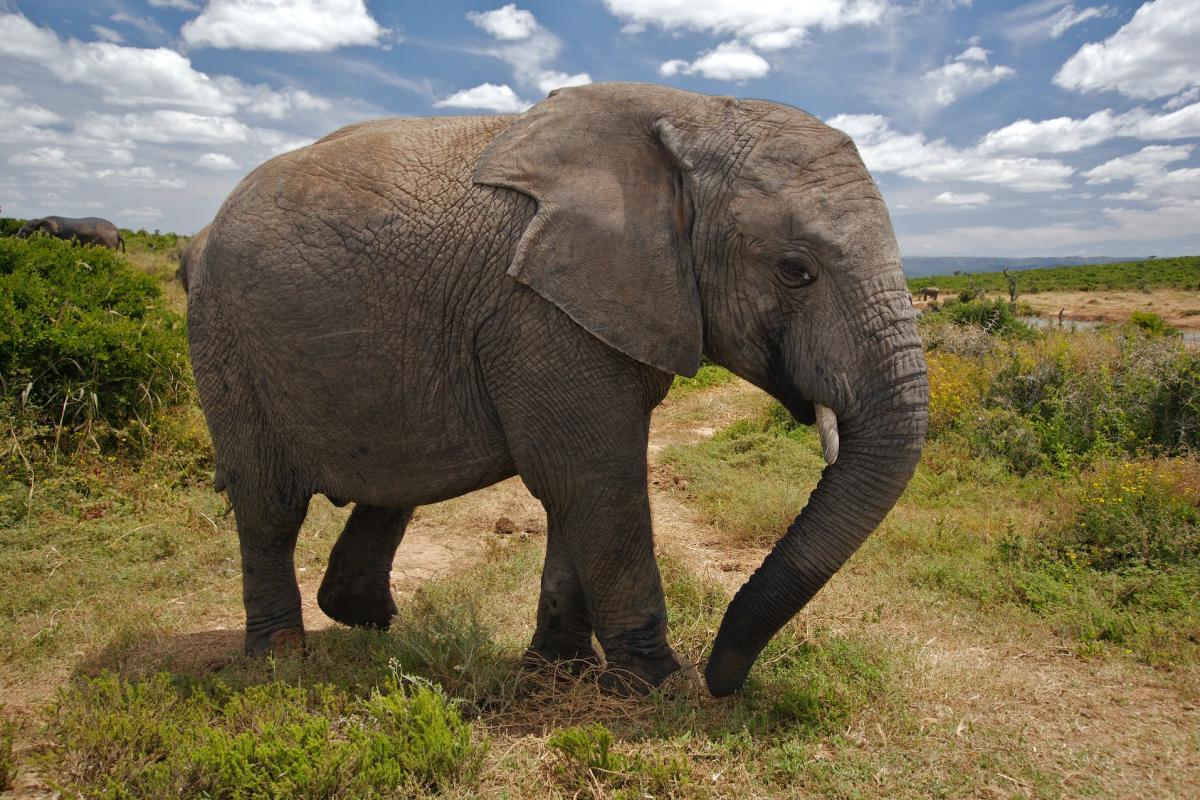
- Name: African bush elephant
- Scientific name: Loxodonta africana
- Conservation status:
The African bush elephant, also known as the African savanna elephant, is the largest terrestrial animal in the world, reaching a shoulder height of up to 3.96 m / 13 ft and a weight of up to 10.4 t / 11.5 short tons! It can be found across 37 African countries, including South Africa, and is seriously endangered because of poaching for its meat and ivory, as well as habitat degradation and loss.
This spectacular mammal is a herbivore that feeds on grasses, leaves, and bark.
12. African leopard
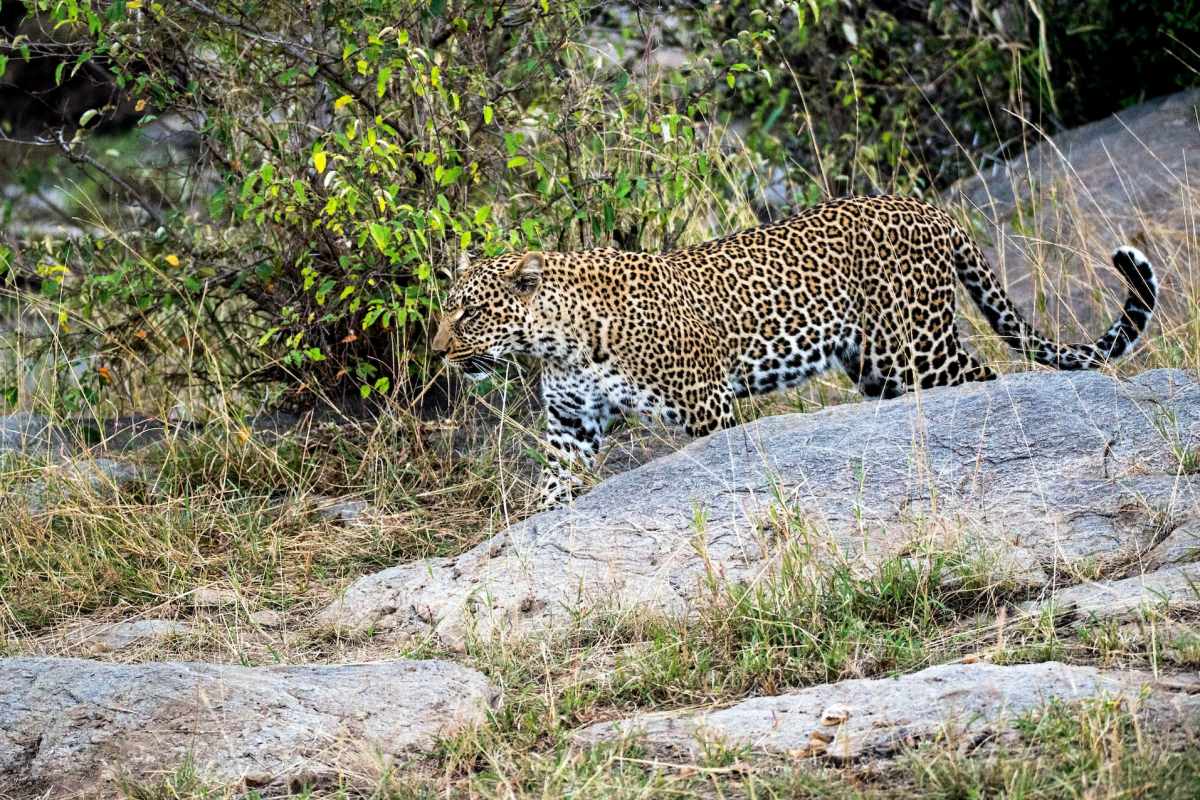
- Name: African leopard
- Scientific name: Panthera pardus pardus
- Conservation status:
The African leopard is the most widely distributed subspecies of the leopard: it can be found throughout much of sub-Saharan Africa, only avoiding arid areas such as sandy deserts, although its range is now very fragmented and scattered.
This big cat is extremely opportunistic and highly versatile and can adapt its dietary habits to prey availability. Most of the time though, it will hunt for large ungulates such as antelopes and buffalos.
13. Southeast African cheetah
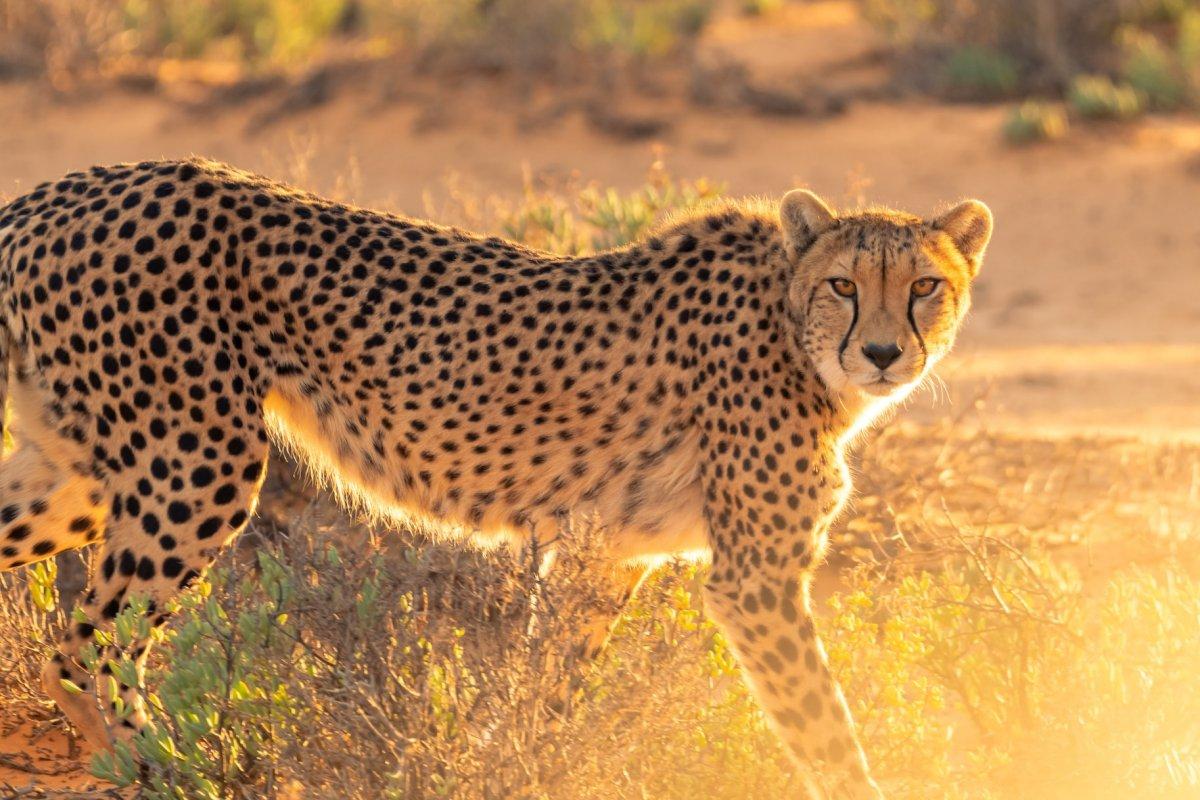
- Name: Southeast African cheetah
- Scientific name: Acinonyx jubatus jubatus
- Conservation status:
The Southeast African cheetah is the subspecies of cheetah found in South Africa. It can also be found in other countries in southern and eastern Africa such as Namibia and Kenya, and usually inhabits lowland areas and deserts, especially the Kalahari.
There are about 1,500 Southeast African cheetahs in South Africa, and they are all endangered by poaching, human encroachment, and habitat loss. They are the fastest terrestrial animals in the world and feed on small to large ungulates, especially antelopes.
14. African wild dog
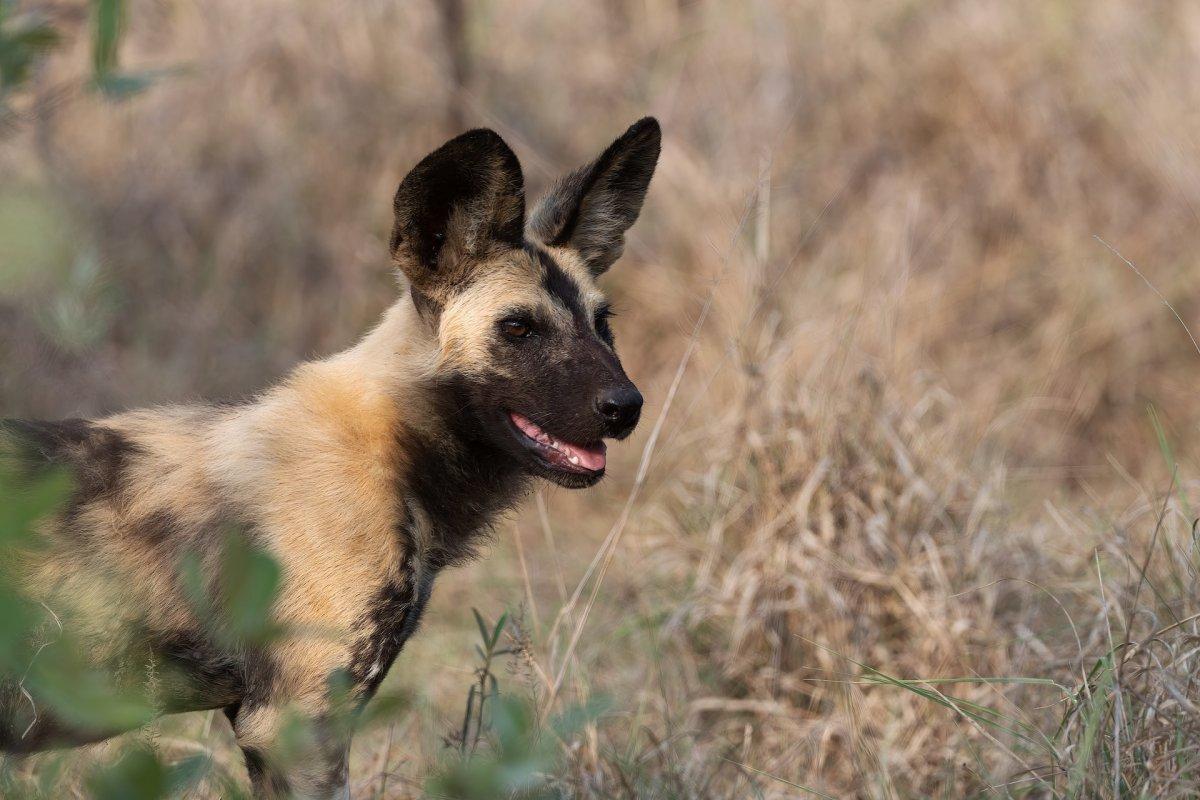
- Name: African wild dog
- Scientific name: Lycaon pictus
- Conservation status:
Speaking of antelopes, there is also arguably the best antelope hunter in the world in South Africa: the African wild dog.
Also known as the African painted dog or the African hunting dog, this wild canid is a specialized pack hunter of antelopes: although not very fast, it is extremely relentless and can endure running on very long distances, which is why it chases antelopes exhaustion.
15. Springbok
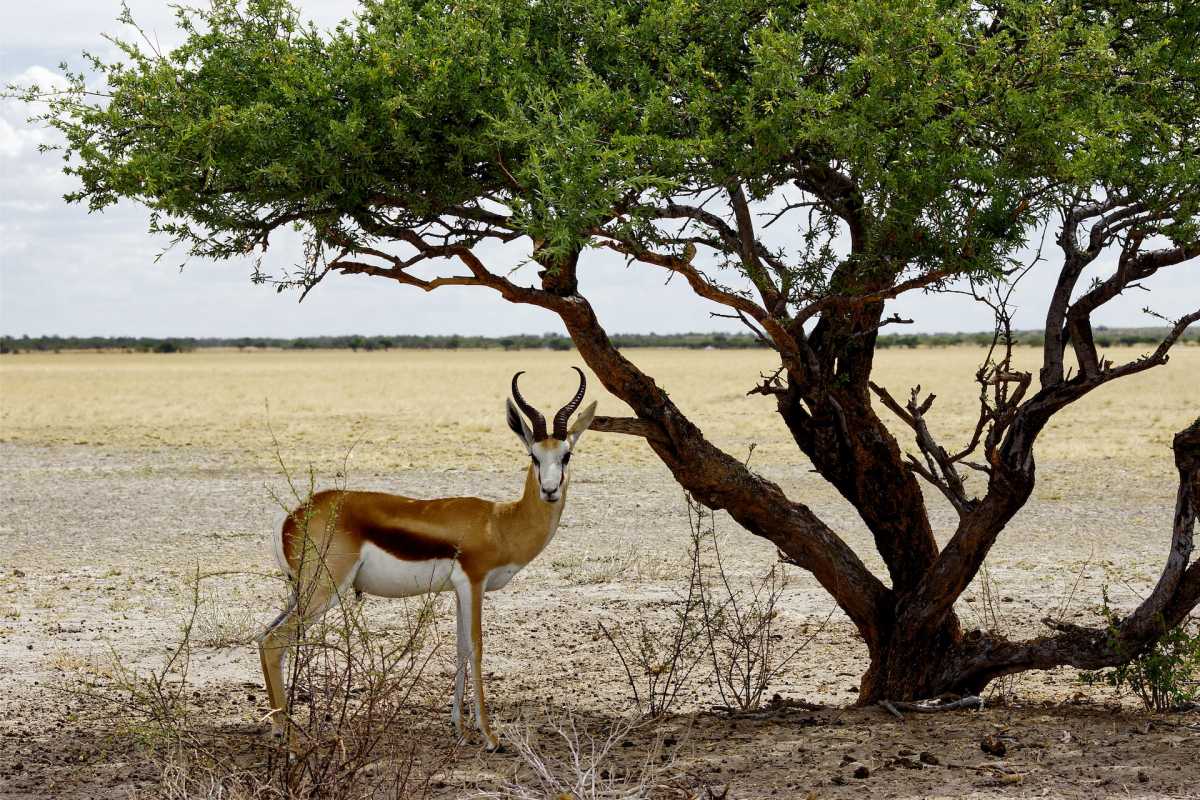
- Name: Springbok
- Scientific name: Antidorcas marsupialis
- Conservation status:
The springbok is a medium-sized species of antelope native to southern and southwestern Africa. It is the national animal of South Africa, and it inhabits dry areas. Thankfully, the springbok is one of the few antelope species with an expanding population, as it faces no major threats to its long-term survival.
In South Africa, the springbok is hunted as a game because of its beautiful coat. Springbok skins are often exported from the country, and the animal is featured on South African stamps and currency.
16. Aardvark
- Name: Aardvark
- Scientific name: Orycteropus afer
- Conservation status:
The aardvark is a peculiar, unique species of mammal found throughout all of sub-Saharan Africa. It almost exclusively feeds on ants and termites which it digs out of their hills with its very powerful claws, and it has a characteristic pig-like snout, one of its kind among insectivores.
Aardvarks can live in captivity without any problem. Its name comes from the Afrikaans for “ground pig” or “earth pig”, which comes from its burrowing habit.
17. Spotted hyena
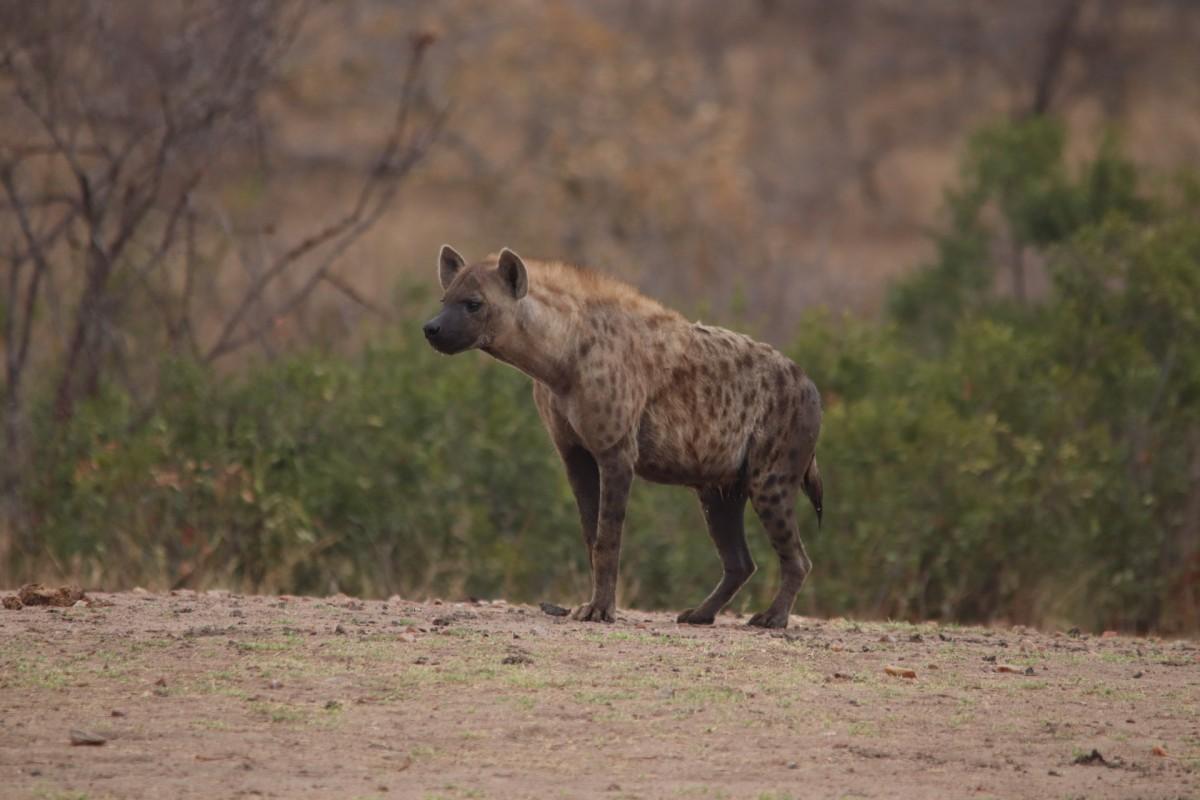
- Name: Spotted hyena
- Scientific name: Crocuta crocuta
- Conservation status:
The spotted hyena, mostly known as the laughing hyena, is a large species of carnivore native to sub-Saharan Africa. It has a bear-like build with rounded ears and is the most common large member of the order Carnivora on the continent.
Dutch colonists immediately saw the intelligence of the spotted hyena in South Africa, during the 19th century. It is said to be both suspicious and cunning, and utilizes deceptive behavior such as emitting alarm calls and frightening other hyenas so they can eat in peace!
18. Common warthog
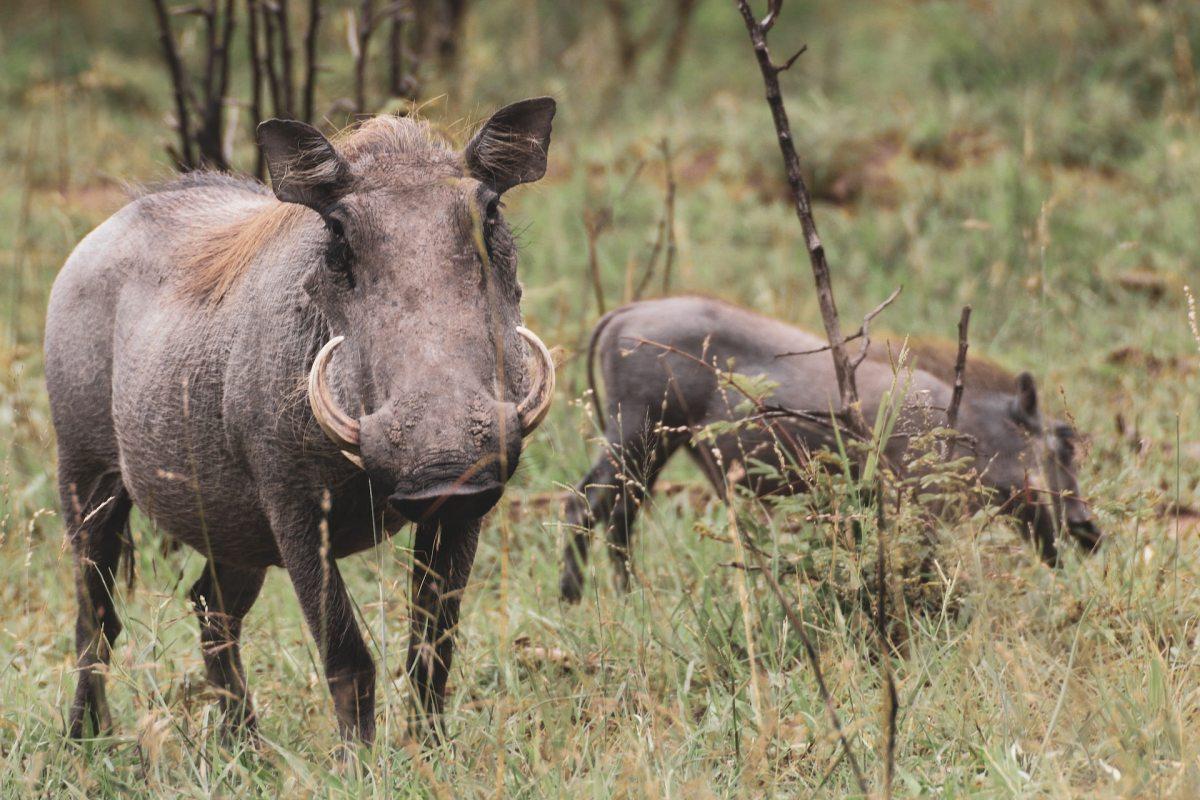
- Name: Common warthog
- Scientific name: Phacochoerus africanus
- Conservation status:
The common warthog is a species of wild pig native to sub-Saharan Africa. It is the only suid adapted to arid environments, and it is plentiful in eastern South Africa.
This mammal is omnivorous and feeds on berries, grasses, roots, and fruits, but also insects, fungi, eggs, and carrion. It is a powerful digger, often seen sniffing the ground. Although it can be a prodigious enemy, even for carnivores as large as leopards, the common warthog is usually quick to flee.
19. Southern African hedgehog
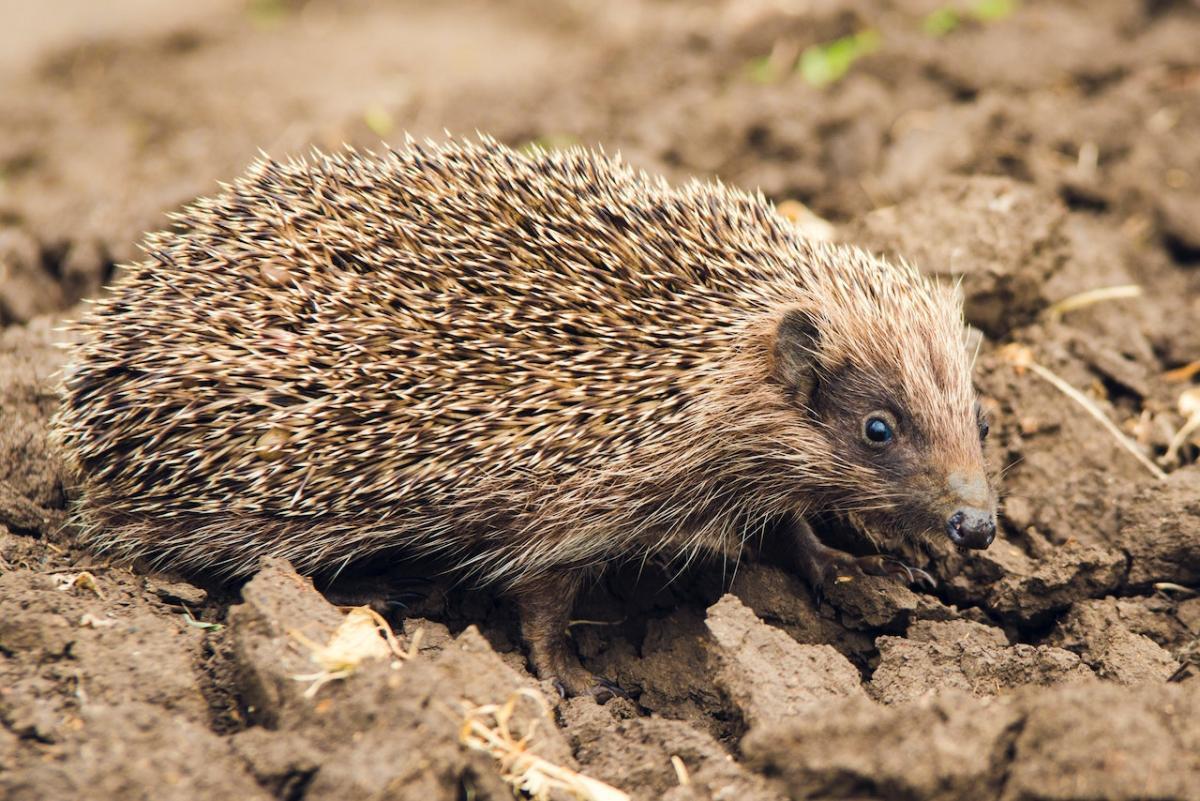
- Name: Southern African hedgehog
- Scientific name: Atelerix frontalis
- Conservation status:
The Southern African hedgehog is a species of mammal native to South Africa, Namibia, Lesotho, Botswana, Angola, Zimbabwe, and Tanzania. Similarly to other hedgehogs, its body is covered by sharp spines known as quills.
Although it is said to be a slow mover, it can move as fast as 7 km/h / 4.3 mph when threatened. It spends its day in an area covered with vegetation or a hole in the ground before emerging at night to forage for food.
20. White rhinoceros
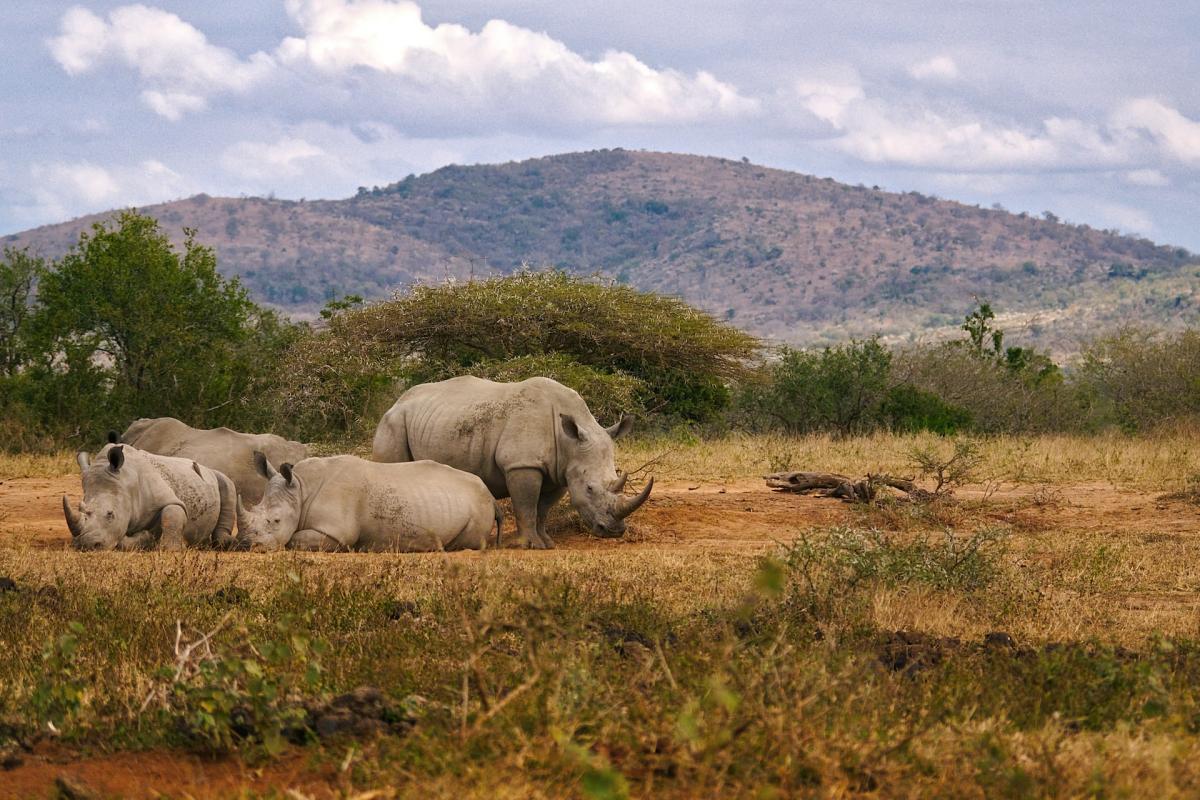
- Name: White rhinoceros
- Scientific name: Ceratotherium simum
- Conservation status:
As you can see, there are two species of rhinoceros in South Africa. The white rhinoceros, also known as the square-lipped rhinoceros, is the largest species of rhino in the world. Similarly to the black rhinoceros, it is not white, and its name most likely comes from the Afrikaans “wijd”, which actually means “wide”, and would have potentially been poorly translated.
The northern subspecies of the white rhinoceros (not present in South Africa), is functionally extinct: only 2 females are left.
21. Impala
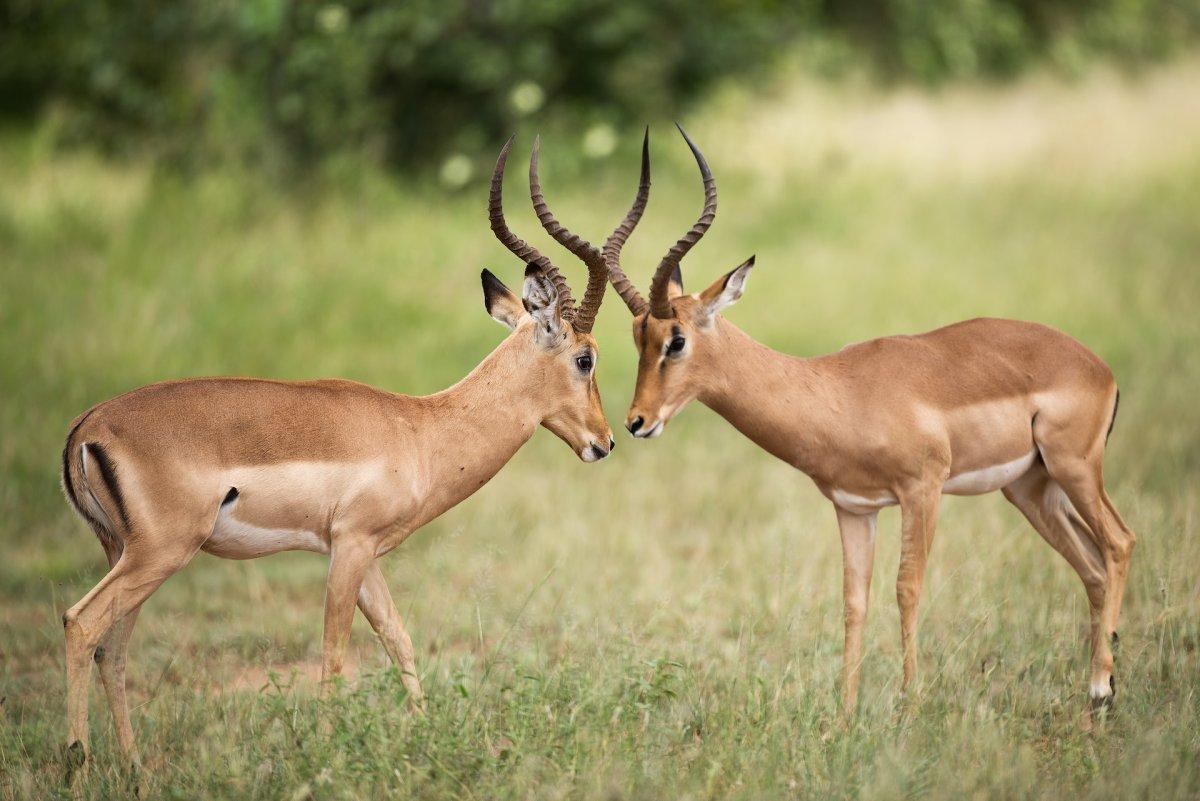
- Name: Impala
- Scientific name: Aepyceros melampus
- Conservation status:
The impala is a medium-sized species of antelope native to southern and eastern Africa. It is active during the day and often gathers in herds of 3 different types: solitary mature males, females and their offspring, and bachelors.
The main South African population of the impala is located in Kruger National Park, in the northeasternmost part of the country. There, they feed on fruits and pods and usually stay near bodies of water.
22. Cape fox
- Name: Cape fox
- Scientific name: Vulpes chama
- Conservation status:
The Cape fox, also known as the silver-backed fox, the asse, or the cama fox, is a small species of fox native to southern Africa. It is very similar in appearance to the fennec fox due to its unusually large ears, but it’s still larger than its North African counterpart.
This fox mainly lives in semi-arid and arid areas and can be found in the western Cape Province of South Africa.
23. Riverine rabbit
- Name: Riverine rabbit
- Scientific name: Bunolagus monticularis
- Conservation status:
The riverine rabbit, also known as the bushman hare or the bushman rabbit, is a species of rabbit endemic to a small area of South Africa’s Northern Cape Province. It is one of the most endangered mammals in the world, with only about 1,500 individuals left, including 500 adults.
This rabbit primarily feeds on vegetation and grasses and is on the verge of extinction because of habitat alteration due to agricultural expansion.
24. Blue wildebeest
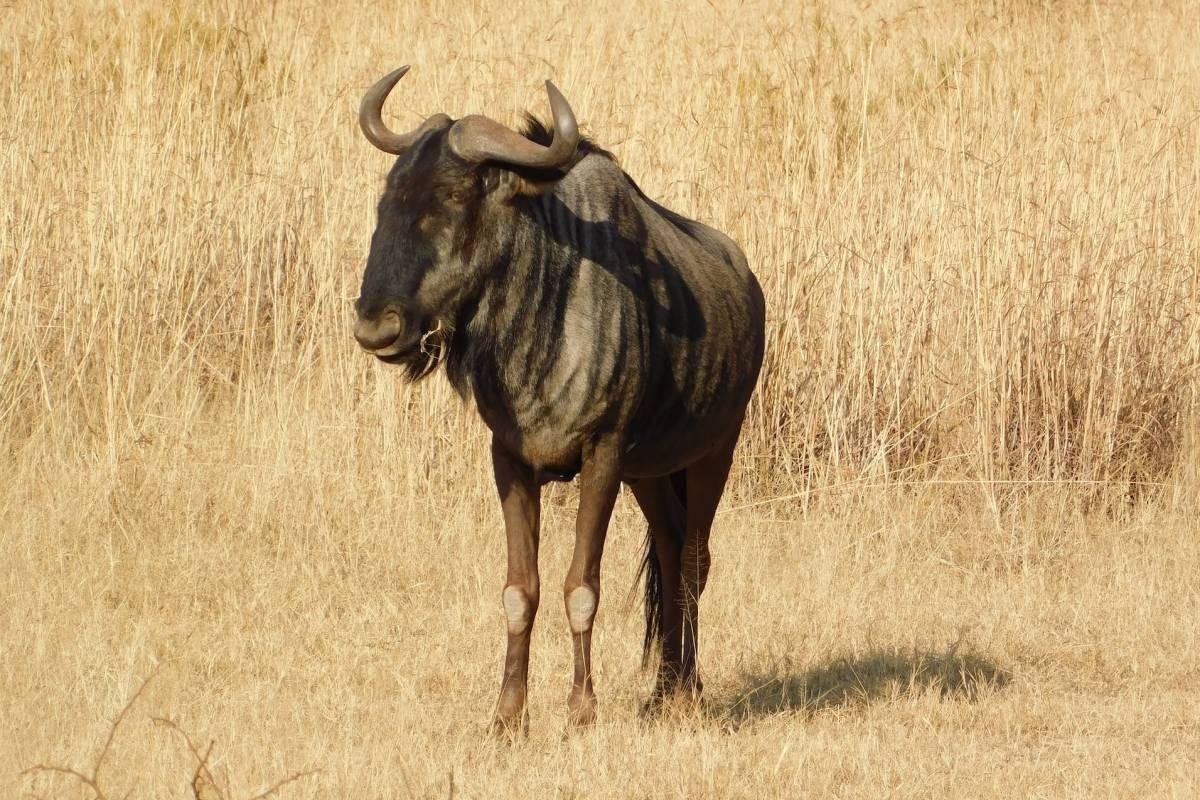
- Name: Blue wildebeest
- Scientific name: Connochaetes taurinus
- Conservation status:
The blue wildebeest, also known as the white-bearded wildebeest, the white-bearded gnu, the common wildebeest, or the brindled gnu, is a large species of antelope native to southern Africa. It is very muscular and has a characteristic, robust muzzle.
This mammal inhabits the plains and savannas of South Africa and neighboring countries, and it usually lives in very large herds, which migrate yearly. Although listed as least concern, it suffers from large-scale deforestation and the drying up of water sources.
25. African penguin
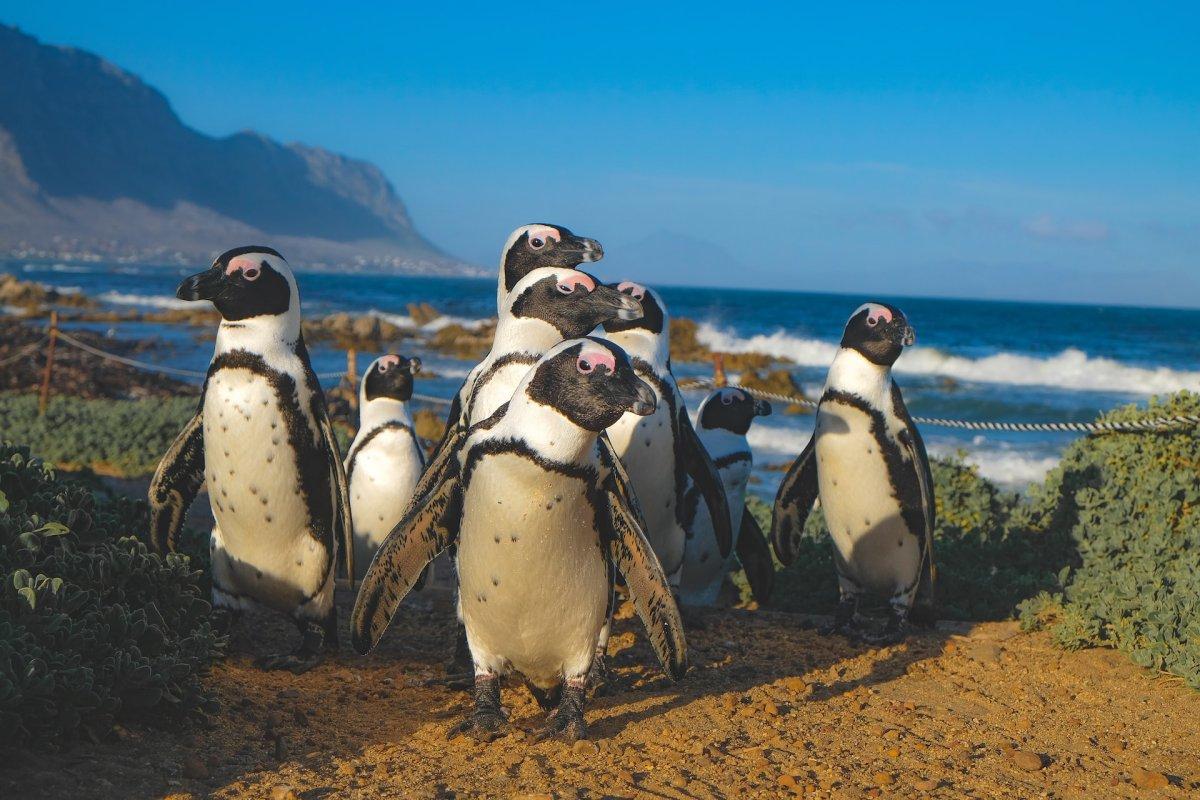
- Name: African penguin
- Scientific name: Spheniscus demersus
- Conservation status:
South Africa is definitely an incredible country, don’t you think? It is home to extremely arid areas, but also to a species of penguin, the African penguin!
Also known as the South African penguin or the Cape penguin, this bird is restricted to South African waters, mainly in the southern and western parts of the country. It makes a very loud, donkey-like noise, and its numbers are rapidly decreasing because of oil spills, competition with fisheries, and the collecting of eggs.
26. Southern bald ibis
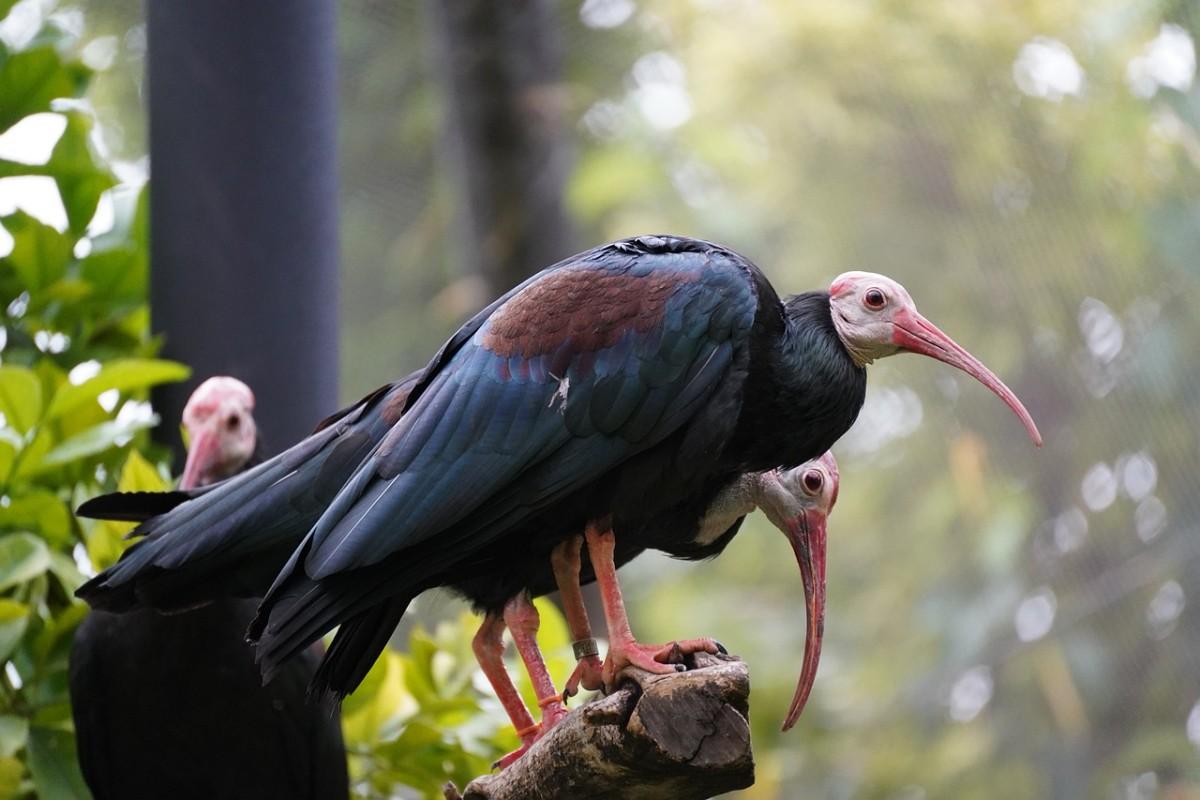
- Name: Southern bald ibis
- Scientific name: Geronticus calvus
- Conservation status:
The southern bald ibis is a large species of bird native to southern Africa. It lives in semi-desert or open grasslands of the mountains, and has a restricted home range, being only found in the southern tips of South Africa.
This ibis is under no threat of immediate extinction but suffers from the illegal wildlife trade and human disturbance. It nests in cliffs and breeds on open ledges, and its diet is made of small terrestrial invertebrates and insects.
27. African clawless otter
- Name: African clawless otter
- Scientific name: Aonyx capensis
- Conservation status:
The African clawless otter, also known as the groot otter or the Cape clawless otter, is a species of freshwater otter native to most of sub-Saharan Africa. It is the second-largest freshwater otter in the world, and has, as its name suggests, clawless feet, but also partially webbed feet.
A hiking trail in South Africa, the Otter Trail, was named after the African clawless otter because it is found in this area. Because said area falls within the Tsitsikamma National Park, this otter is strictly protected.
28. Caracal
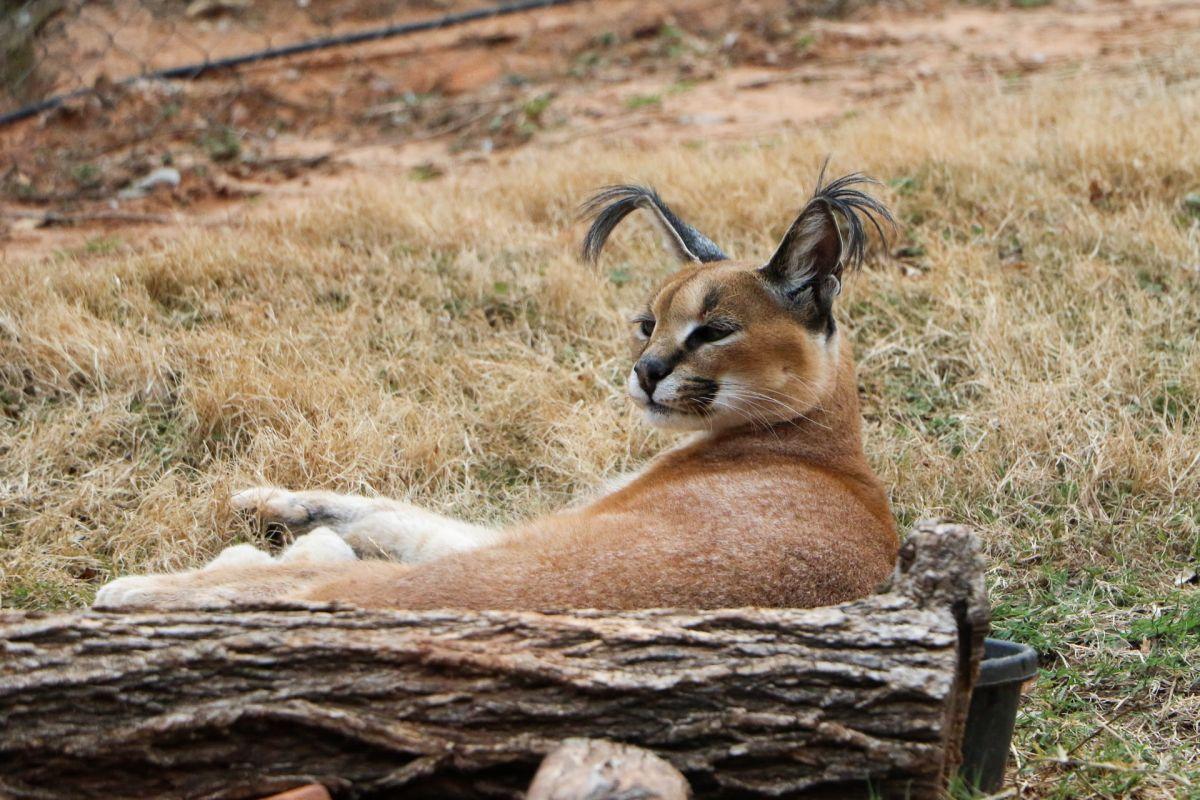
- Name: Caracal
- Scientific name: Caracal caracal
- Conservation status:
The caracal is a medium-sized species of wild cat native to sub-Saharan Africa, but also Central Asia, the Indian subcontinent, and the Middle East. It has a slender build with long legs, as well as tufted ears, and is an agile predator which mainly feeds on birds and small mammals.
In South Africa, it preys on several species of mammals such as the Cape grysbok, the common duiker, the rock hyrax, and hares.
29. Cape grysbok
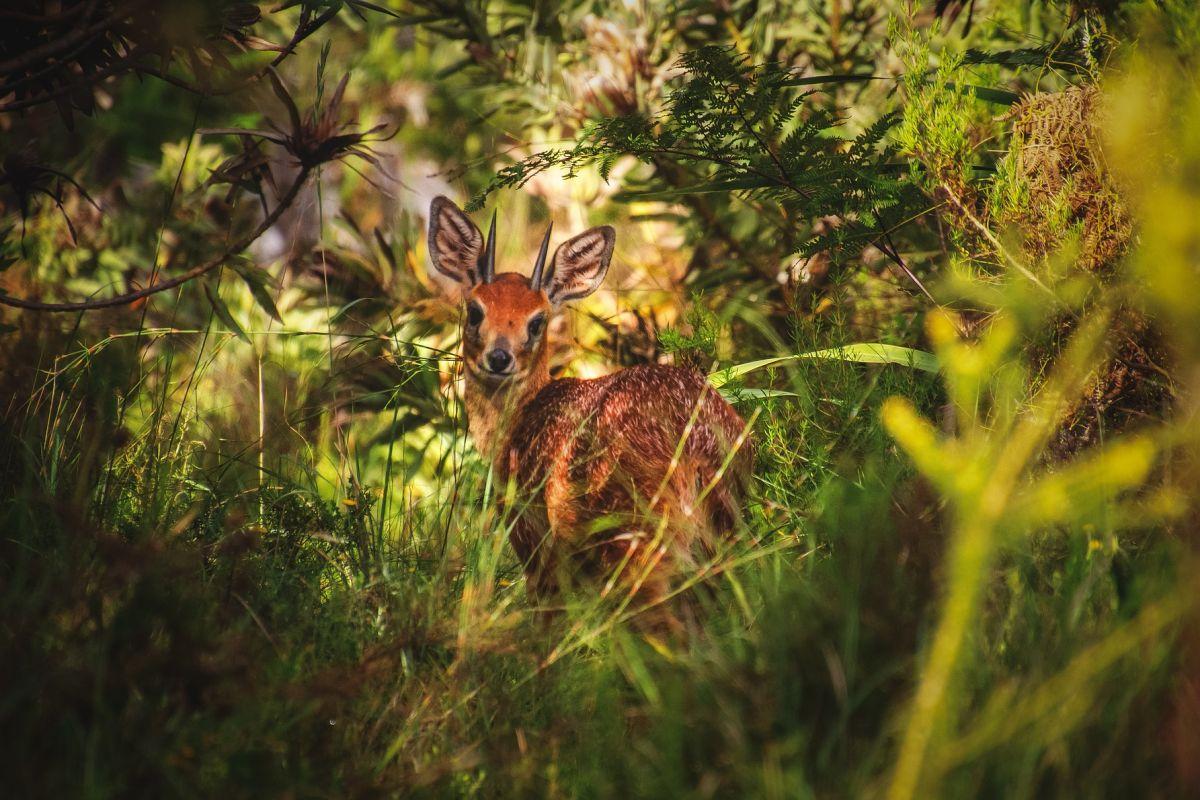
- Name: Cape grysbok
- Scientific name: Raphicerus melanotis
- Conservation status:
In case you were wondering what the Cape grysbok that I just talked about was, there it is!
Also known as the southern grysbok, it is a small species of antelope endemic to the Western Cape region of South Africa. It has a reddish sandy coat and inhabits thick shrubland. Sometimes, it can be sighted near urban edges, as well as along the riverbed of the southern Karoo.
30. Serval
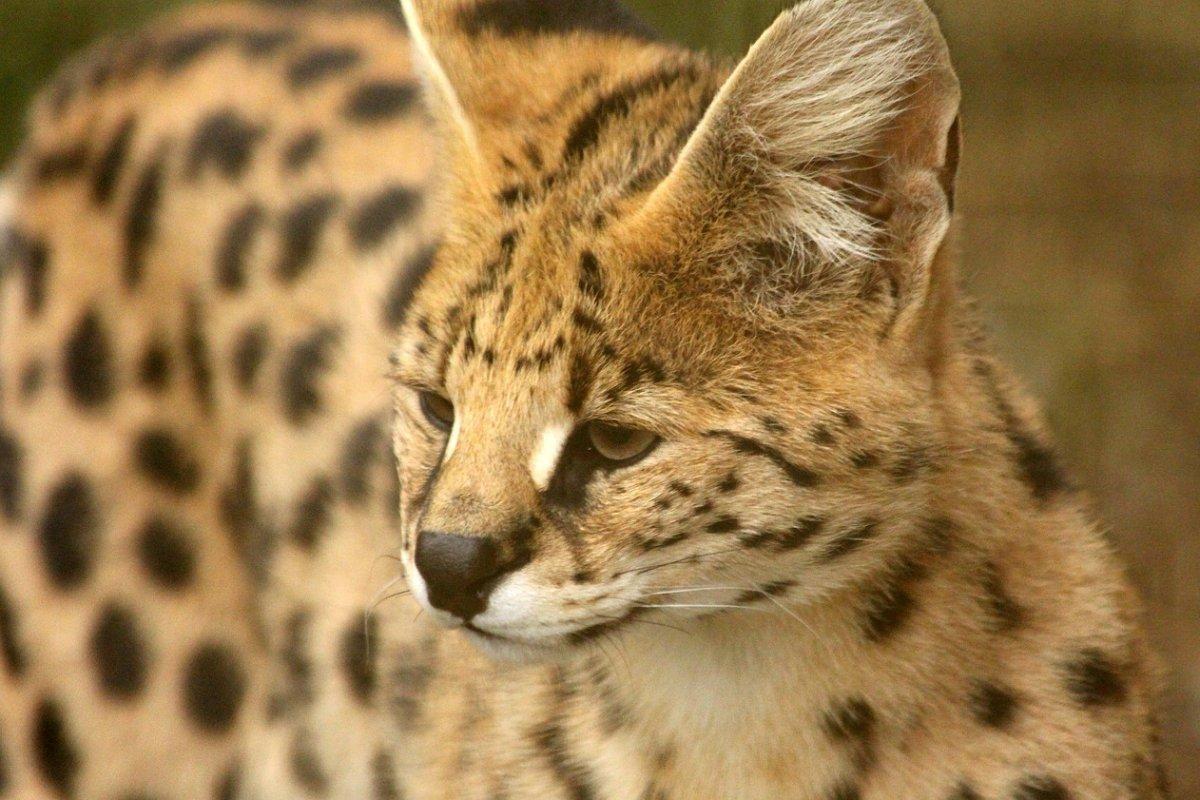
- Name: Serval
- Scientific name: Leptailurus serval
- Conservation status:
The serval is a species of wild cat native to Africa. Although pretty rare in the Sahel and North Africa, it is spread throughout much of the rest of the continent, and usually lives anywhere outside of rainforest regions.
This felid is solitary and carnivorous and can be found in the Free State, the eastern Northern Cape, and the southern North West in South Africa. Hunting it is prohibited within the country.
31. Meerkat
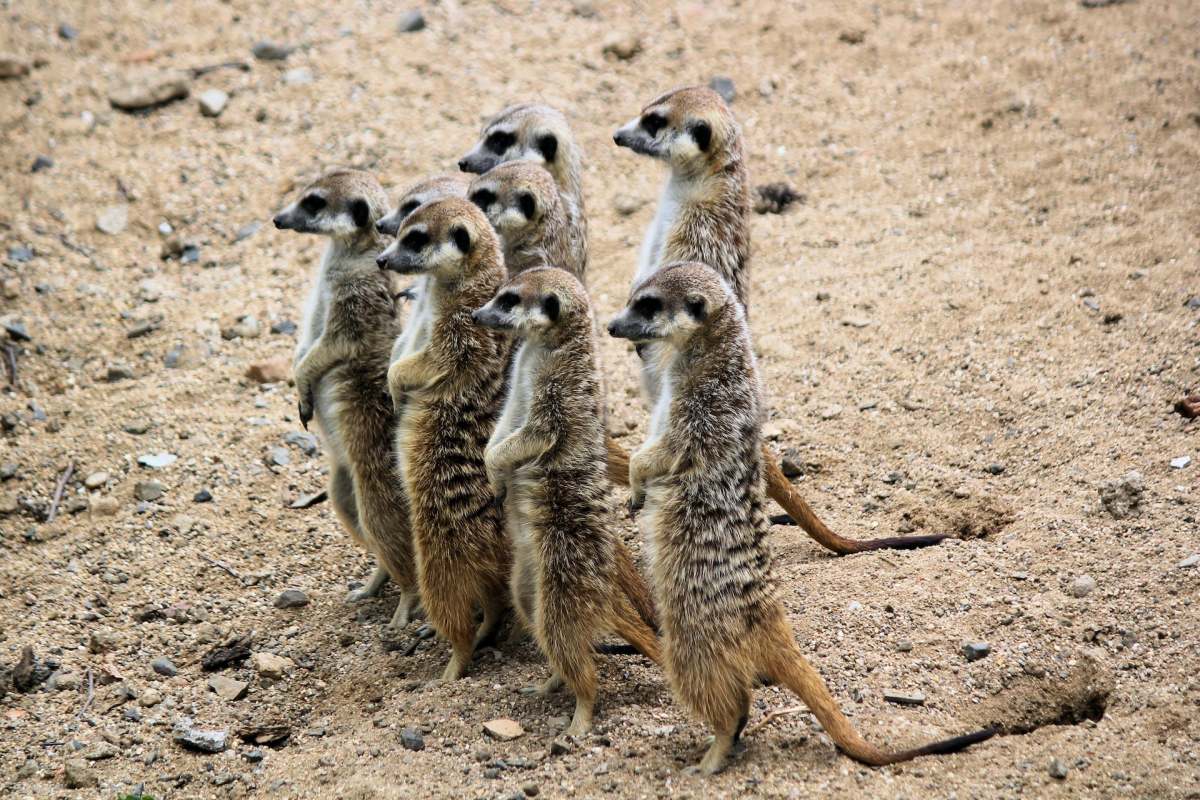
- Name: Meerkat
- Scientific name: Suricata suricatta
- Conservation status:
The meerkat, also known as the suricate, is a small species of mongoose native to southern Africa. It is known for its tendency to stay on its hind legs, usually as a group of multiple individuals, and for quickly running into its burrows when alarmed.
This mammal lives in groups of 2 to 30 individuals and can be found in northern and western South Africa. The name used locally is the suricate, which probably derives from the French.
32. African wildcat
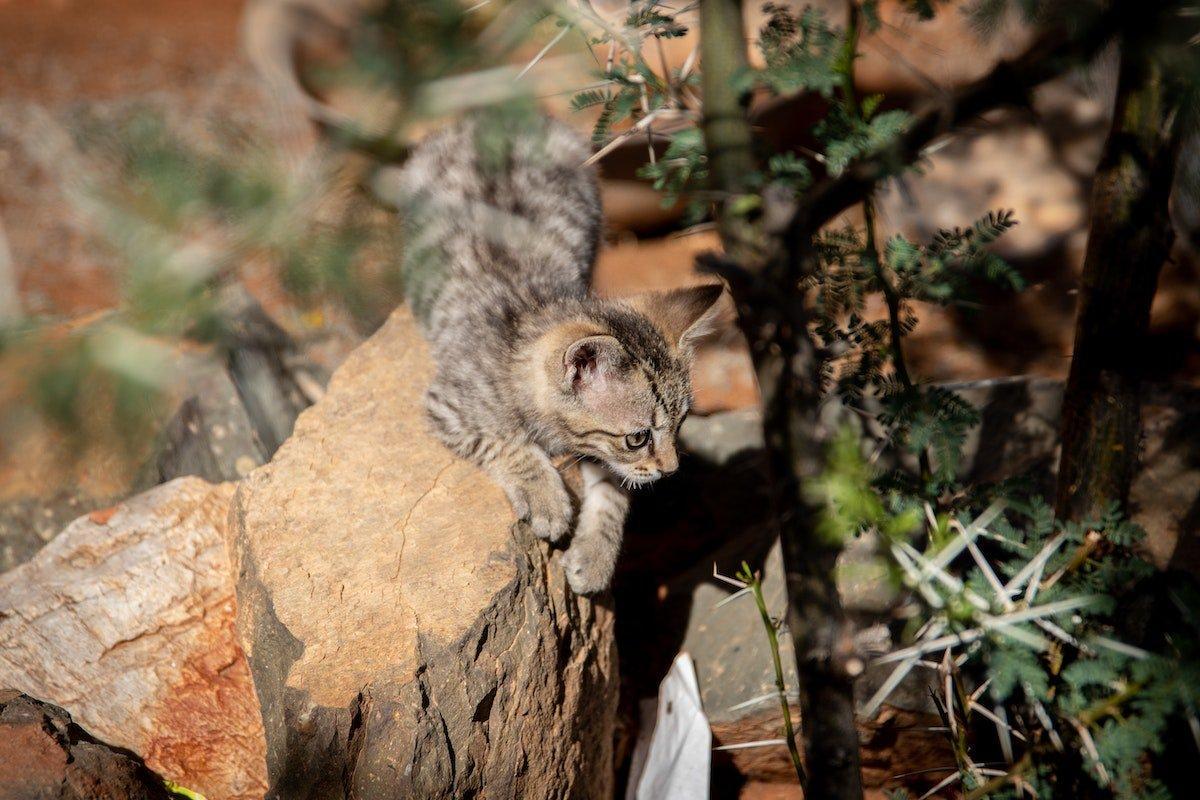
- Name: African wildcat
- Scientific name: Felis lybica
- Conservation status:
There are also much less scary and dangerous species of wild cats in Africa, such as the African wildcat. Spread throughout the continent, as well as in Central and West Asia, it is one of the first pieces of evidence of an association between a human and a cat, because of an African cat’s skeleton found in a burial site next to a human’s, in Cyprus!
This cat is nocturnal and has very precise hearing which allows it to find its prey, mainly rodents, small mammals, and insects.
33. Brown fur seal
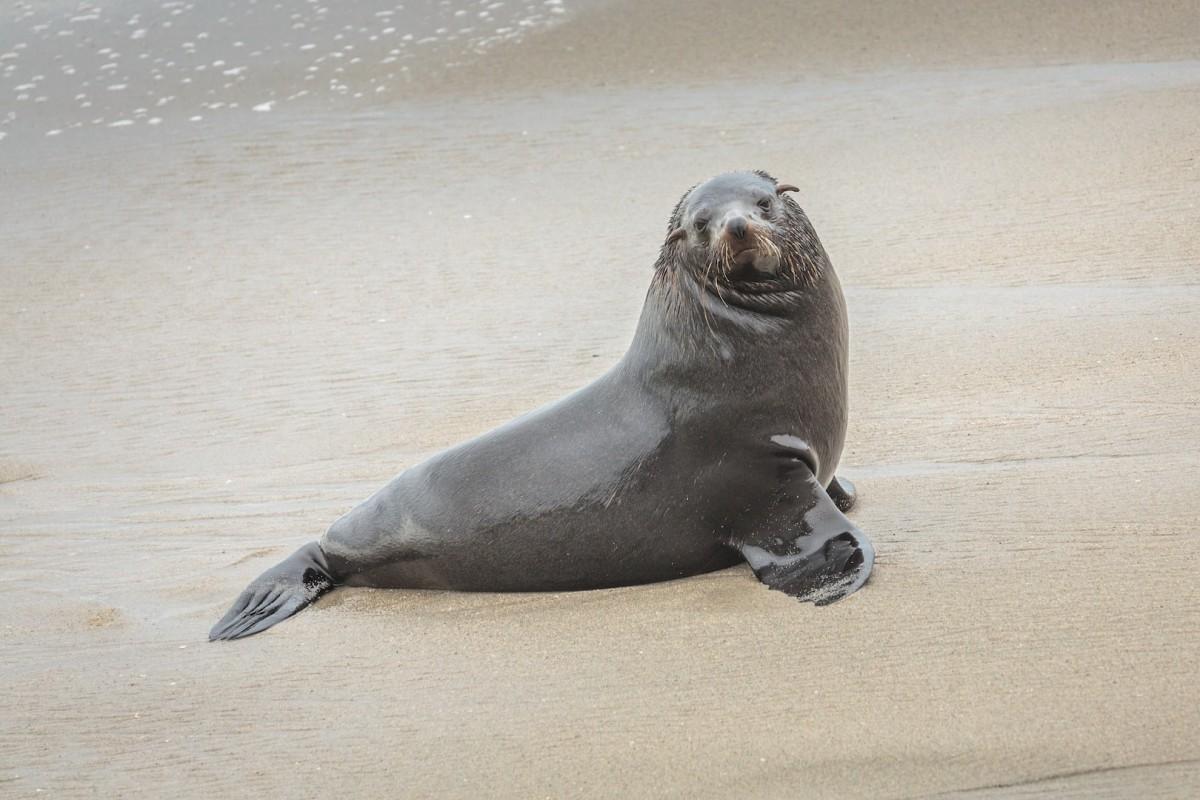
- Name: Brown fur seal
- Scientific name: Arctocephalus pusillus
- Conservation status:
The brown fur seal, also known as the Australian fur seal, the South African fur seal, or the Cape fur seal, is a species of fur seal native to the southernmost parts of Oceania and Africa, namely the southeastern coast of Australia and the southwestern coast of Africa.
Although it is usually attacked by sharks, one peculiar specimen, off Cape Point in South Africa, attacked and killed 5 blue sharks, most likely to feed on the fish in their stomach!
—
So there you have them, these were my 33 wild animals of South Africa. I hope you enjoyed this list and that you learned something new today.
In case you want to learn more about South Africa wildlife, feel free to keep reading, as I still have lots of things to tell you about:
Endangered Animals of South Africa
This is definitely the saddest part of the South African animals list, but it is very important to raise awareness. Because of this, let’s go through the list of endangered animals in South Africa.
Here are the animals in danger of extinction in South Africa.
- Bluebuck
- Günther’s dwarf burrowing skink
- Eastwood’s long-tailed seps
- Durban dwarf burrowing skink
- Geometric tortoise
- Black rhino
- Cape flats frog
- Rose’s mountain toadlet
- and 35 more…
- African savanna elephant
- Northern royal albatross
- Gray reef shark
- Kloof frog
- Eastern cape rocky
- and 115 more…
To see the full list of endangered species in South Africa, head over to the International Union for Conservation of Nature’s Red List.
What is the National Animal of South Africa?
The national animal of South Africa is the springbok.
The springbok is a unique species of gazelle, particularly adapted to the open grass plains and the dry, barren areas of South Africa. It can be found in the Karoo, the North West province, and the Free State, and its name literally means “jumping antelope” (it is, in fact, known for its tendency to jump instead of running).
You may have heard of the South African rugby national team’s name, “The Springboks”, which obviously comes from their national emblem.
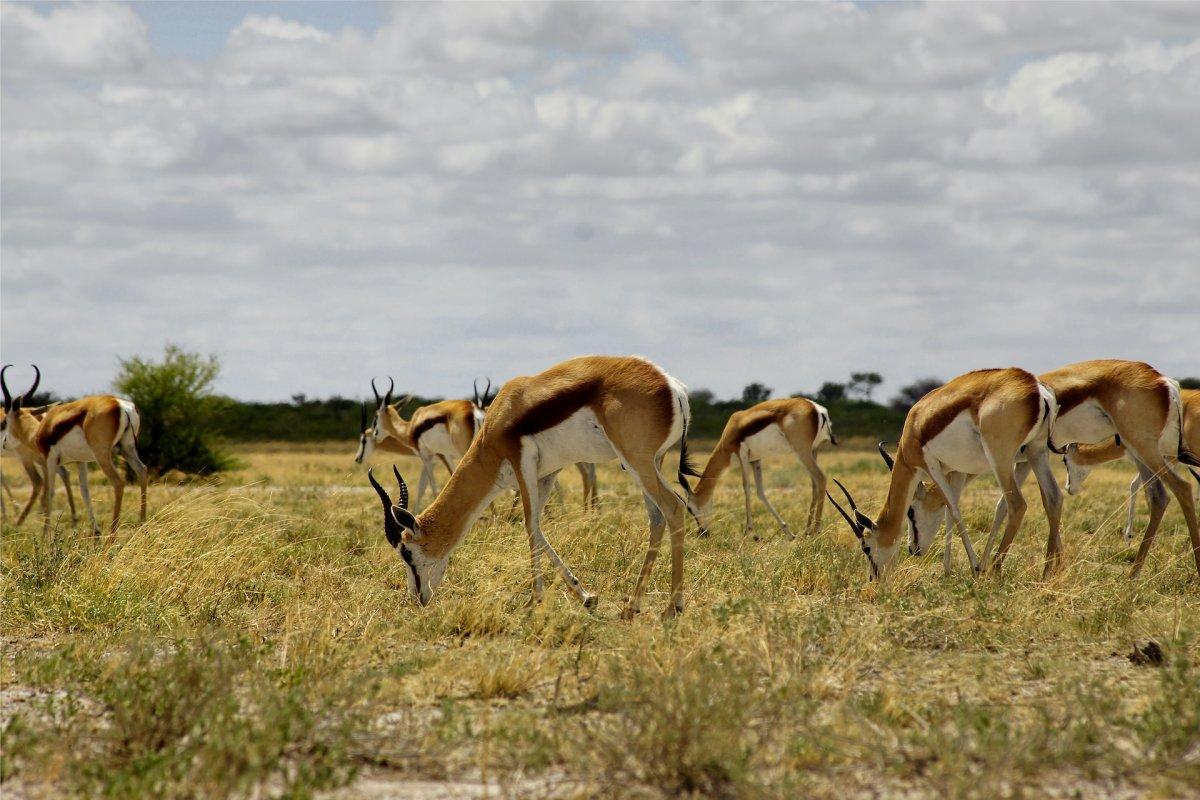
How Many Animals Native to South Africa?
What is the diversity of native animals in South Africa?
Let’s look at the total number of species of Chordata (mammals, birds, fishes, and reptiles).
Total number of animal species in South Africa: 3,597 (14,205 in total in sub-Saharan Africa)
More About Animals in the World!
Loved these South Africa animal facts? Want to see what animals live in other countries?
Then check out these posts:
Or click here to see ALL the facts up on the blog! Spoiler alert: there’s A LOT of them.
Share the knowledge! Click on the buttons below to share information about these famous animals that live in South Africa with your friends, and help them learn more about the world 🙂
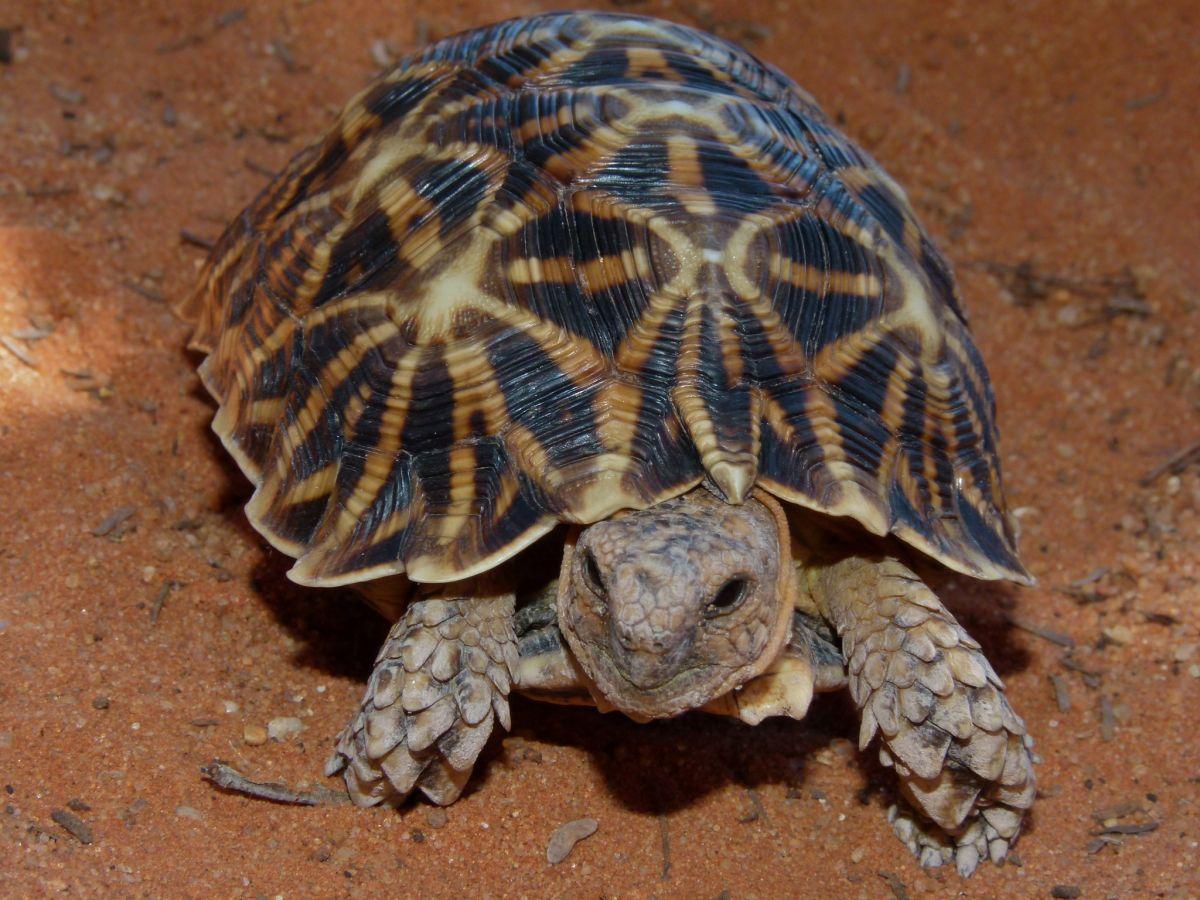
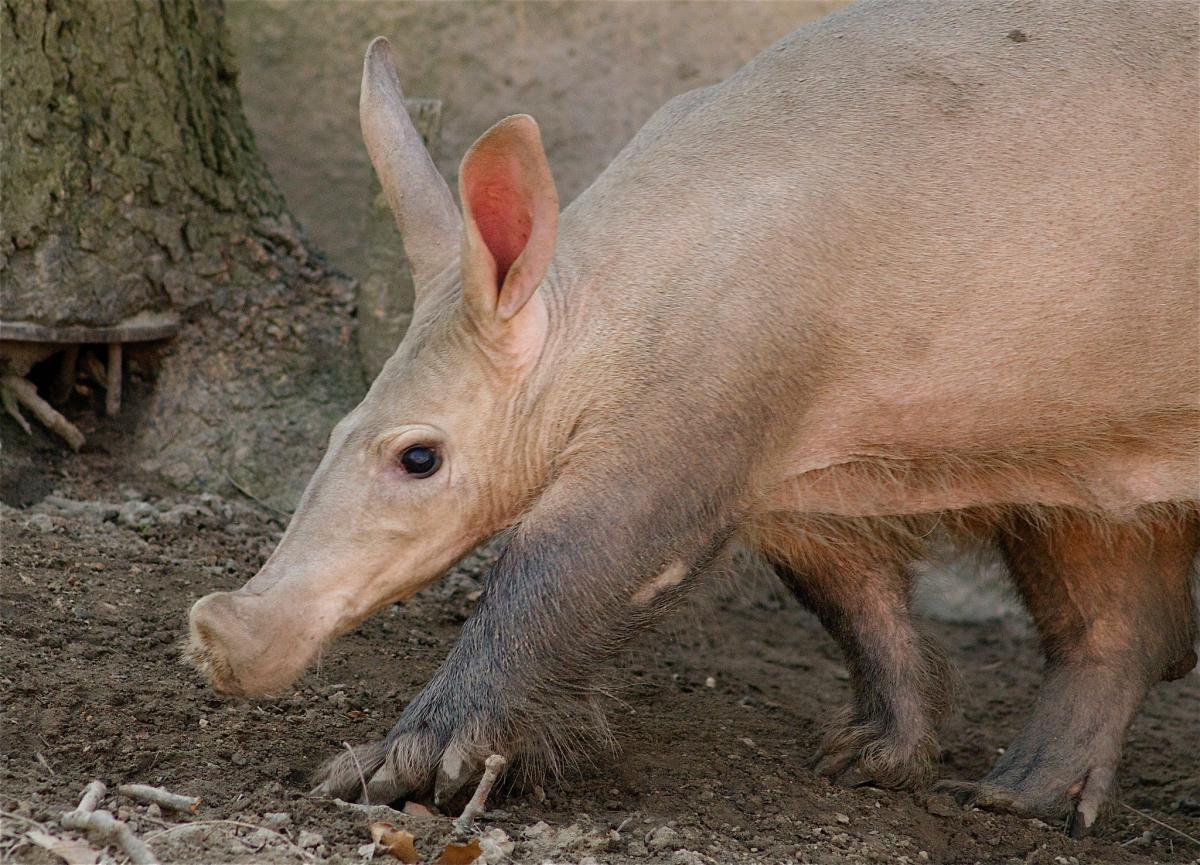
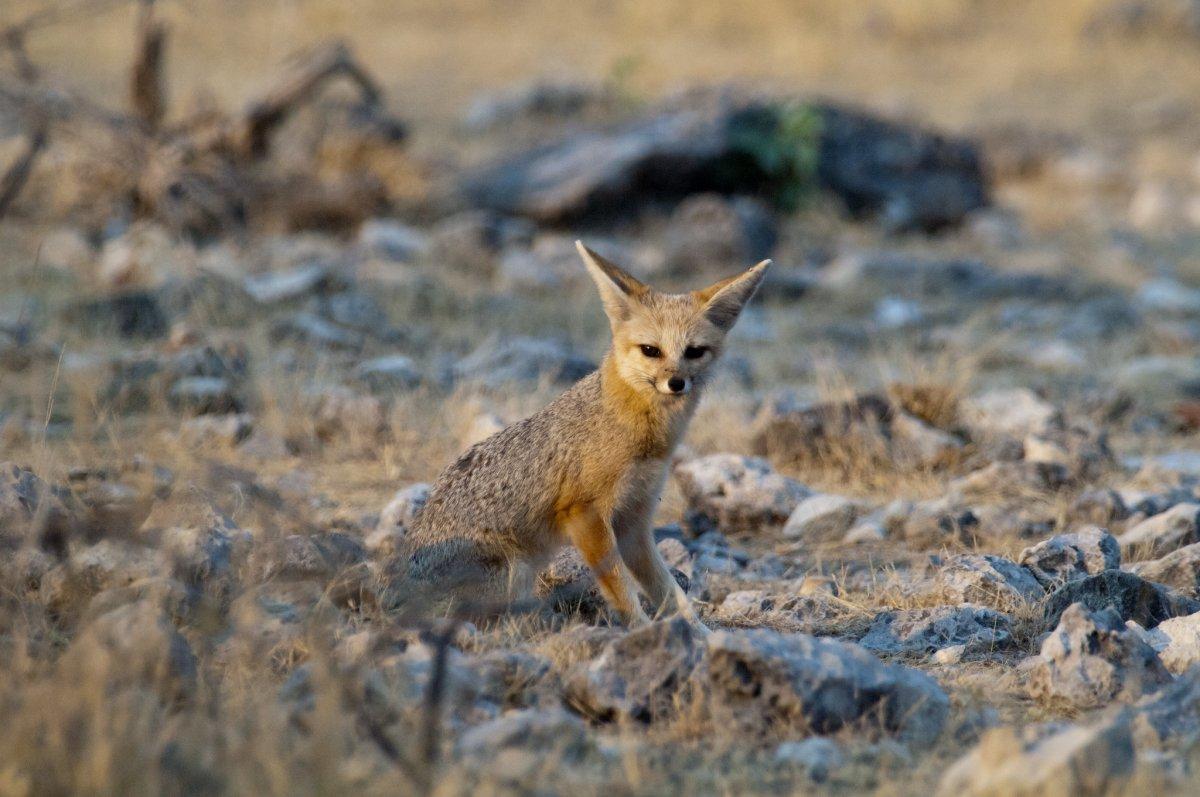
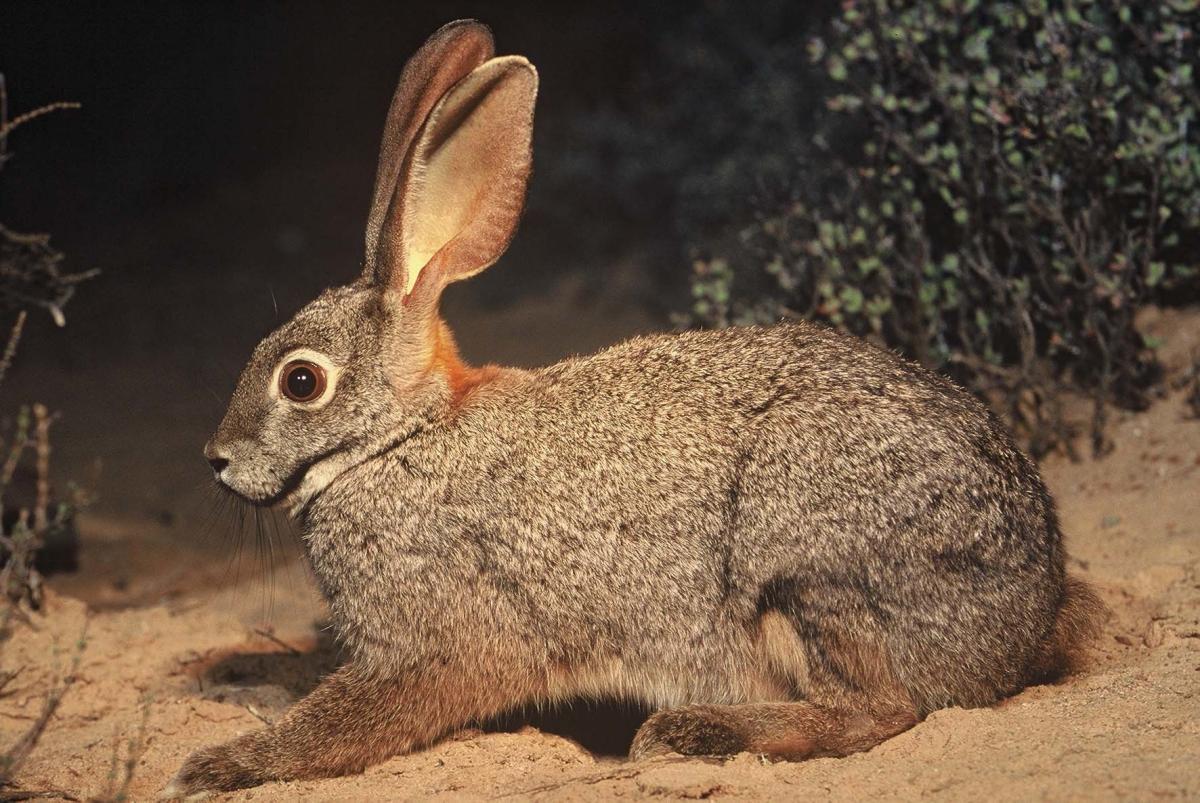
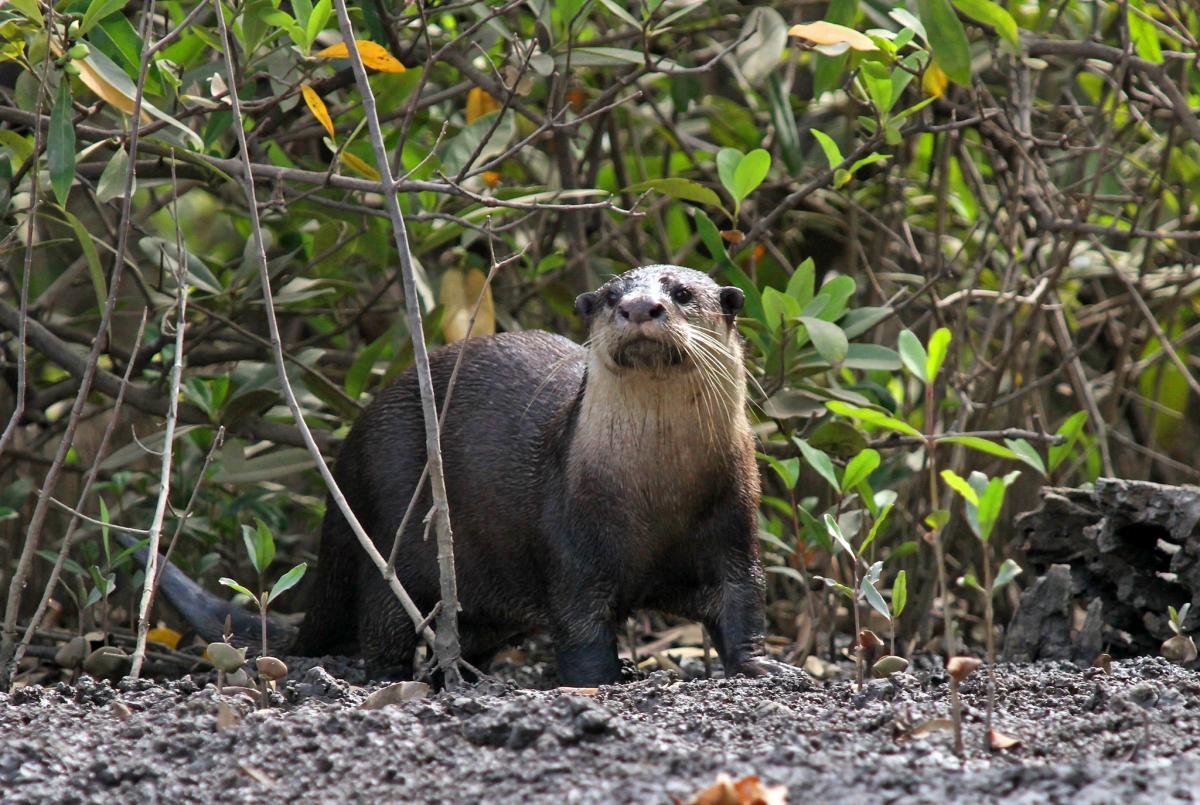

![21 Wild Animals in Bhutan [Wildlife in Bhutan]](https://www.kevmrc.com/wp-content/uploads/2022/12/21-wild-animals-in-bhutan.jpg)
![10 Wild Animals in Liberia [Wildlife in Liberia]](https://www.kevmrc.com/wp-content/uploads/2022/12/10-wild-animals-in-liberia.jpg)
![14 Wild Animals in Argentina [Wildlife in Argentina]](https://www.kevmrc.com/wp-content/uploads/2022/06/14-wild-animals-in-argentina.jpg)